#and they make less major changes to combat system usually than a series like final fantasy that makes significantly different changes each g
Explore tagged Tumblr posts
Text
Final Fantasy 7 Remake
I had a love-hate relationship with Final Fantasy for a long time. Outside of Final Fantasy Tactics, I’ve never connected with a game in the series despite being a self-proclaimed JRPG fan. I just never managed to find the fun with them. That includes Final Fantasy VII. I remember playing it. I think I made it a little bit into disc 2 before moving onto something else.
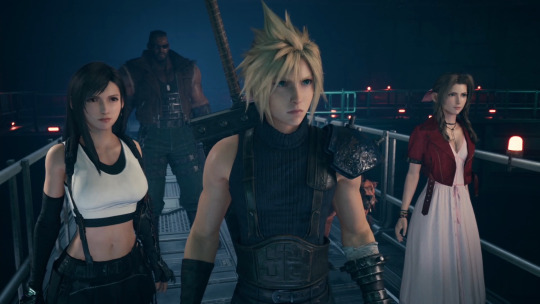
So, unlike a lot of folks, I was not anxiously awaiting the remake. Nor was I precious about preserving the sanctity of the original release. For me, it was just a major JRPG release. I usually play those. And so I plunged into my Final Fantasy 7 Remake experience.**
Right off the rip, I love the new combat system. You’re running around and attacking in real time, but when you go into a menu to use an ability or an item, the game slows to down to a crawl that might as well be a pause. This would have saved Final Fantasy X-2 for me. Please, please, PLEASE do not batter me about while I’m digging through menus.

You start off playing as just mopey, grumpy, emo-ass bitch boy Cloud Strife but soon you’ll have a small gang of outlaws and attractive young ladies joining you in combat. Swapping between characters is painless and makes combat feel more interactive than most in the genre.
The game gets into a lot of currently relevant topics such as class disparity, climate change, and the harm inflicted by unchecked, powerful corporations. Even if the game doesn’t always handle these things with the most serious tone* it feels more real and relatable than “The Big Evil is taking over and going to destroy the entire planet.” The story mostly takes place in a poor, working-class community living quite literally beneath the wealthy elites up above them who are killing to planet for their own gains.
Sound familiar?
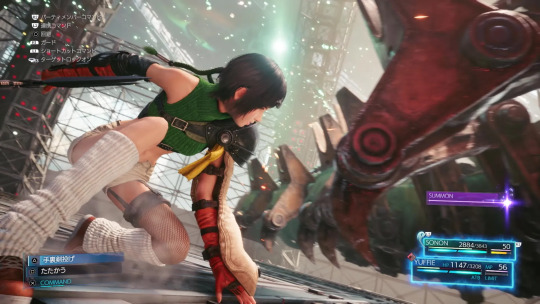
Anyhoo, Square Enix some way, somehow, announced this game too early, made everyone wait and wait for it, made considerable STORY changes to a beloved classic game...and pulled it off. They could have played it safe with this remake and stuck to the original script, but they bet on themselves and it paid off. It lets players old and new play a game with fresh eyes. Veterans don’t know with certainty where the story is going. Would I feel the same if I had the original release up on a pedestal? I’d like to think so.
I had some concerns with how some aspects of the story would hold up some 20 years later. Like a lot of 90′s media, there’s some casual homophobia going on with Final Fantasy 7. And Cloud’s whole brooding “I’m an asshole because I have a tortured past” along with Aerith and Tifa fawning over him because they can fix him...it all feels a little tired now. Still, the optimism of Tifa and Aerith are a refreshing counter to Cloud’s darkness, and the “Who is best girl?” debate is still alive and well. Tifa? Aerith? Maybe Jessie, who just wants to be Cloud’s fuck buddy? No wrong answers here.

And the whole Honeybee Inn section with Cloud crossdressing was absolutely terrific. Less terrific was the whole Don Corneo section. Some pretty gross implications with Tifa and Aerith being gassed, then left to be gang raped by the dudes that work for Corneo. That made his whole over the top, bumbling persona play pretty poorly for me. Then again, maybe the developers wanted me to feel uncomfortable and to really hate that dude. Mission accomplished.
The DLC centered around Yuffie was a blast as well. She’s fun to play, the Fort Condor minigame was more engaging than it had any right to be, and it got me ready to go for Final Fantasy 7 Rebirth which should be out within the year. I do wish Yuffie would button her shorts all way up considering her age, but that’s a me problem. Playing Crisis Core sold me on Zack as a great foil to Cloud personality-wise. I’ll take oblivious and optimistic over mopey and brooding any day of the week.
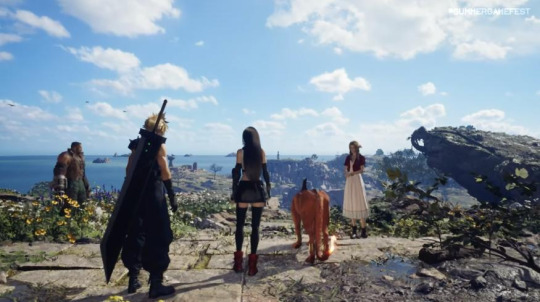
I’m all in on whatever Square Enix wants to do with the franchise. Nomura take the wheel.
*Nor is it trying to, and I don’t need my Final Fantasy games to be gravely serious **Final Fantasy 7 Remake will forever be entrenched in my mind as last game I played pre-pandemic.
3 notes
·
View notes
Text
A Taxonomy of Magic
This is a purely and relentlessly thematic/Doylist set of categories.
The question is: What is the magic for, in this universe that was created to have magic?
Or, even better: What is nature of the fantasy that’s on display here?
Because it is, literally, fantasy. It’s pretty much always someone’s secret desire.
(NOTE: “Magic” here is being used to mean “usually actual magic that is coded as such, but also, like, psionics and superhero powers and other kinds of Weird Unnatural Stuff that has been embedded in a fictional world.”)
(NOTE: These categories often commingle and intersect. I am definitely not claiming that the boundaries between them are rigid.)
I. Magic as The Gun That Can Be Wielded Only By Nerds
Notable example: Dungeons & Dragons
Of all the magic-fantasies on offer, I think of this one as being the clearest and most distinctive. It’s a power fantasy, in a very direct sense. Specifically, it’s the fantasy that certain mental abilities or personality traits -- especially “raw intelligence” -- can translate directly into concrete power. Being magical gives you the wherewithal to hold your own in base-level interpersonal dominance struggles.
(D&D wizardry is “as a science nerd, I can use my brainpower to blast you in the face with lightning.” Similarly, sorcery is “as a colorful weirdo, I can use my force of personality to blast you in the face with lightning,” and warlockry is “as a goth/emo kid, I can use my raw power of alienation to blast you in the face with lightning.”)
You see this a lot in media centered on fighting, unsurprisingly, and it tends to focus on the combative applications and the pure destructive/coercive force of magic (even if magic is notionally capable of doing lots of different things). It often presents magic specifically as a parallel alternative to brawn-based fighting power. There’s often an unconscious/reflexive trope that the heights of magic look like “blowing things up real good” / “wizarding war.”
II. Magic as The Numinous Hidden Glory of the World
Notable examples: Harry Potter, The Chronicles of Narnia, H.P. Lovecraft’s Dream Cycle
The point of magic, in this formulation, is that it is special. It is intrinsically wondrous and marvelous. Interacting with it puts you in a heightened-state-of-existence. It is -- ultimately -- a metaphor for The Secret Unnameable Yearnings of Your Soul, the glorious jouissance that always seems just out of reach.
It doesn’t so much matter how the magic actually functions, or even what outcomes it produces. The important thing is what magic is, which is...magical.
This is how you get works that are all about magic but seem entirely disinterested in questions like “what can you achieve with magic?,” “how does the presence of magic change the world?,” etc. One of the major ways, anyway.
The Numinous Hidden Glory fantasy often revolves around an idea of the magic world, the other-place where everything is drenched in jouissance. [Sometimes the magic world is another plane of existence, sometimes it’s a hidden society within the “real world,” doesn’t matter.] The real point of magic, as it’s often presented, is being in that magic world; once you’re there, everything is awesome, even if the actual things you’re seeing and doing are ordinary-seeming or silly. A magic school is worlds better than a regular school, because it’s magic, even if it’s got exactly the same tedium of classes and social drama that you know from the real world.
Fantasies of this kind often feature a lot of lush memorable detail that doesn’t particularly cohere in any way. It all just adds to the magic-ness.
III. Magic as the Atavistic Anti-Civilizational Power
Notable examples: A Song of Ice and Fire, Godzilla
According to the terms of this fantasy, the point of magic is that it doesn’t make sense. It doesn’t make sense within the logic of civilized human thought, anyway. It is nature and chaos given concrete form; it is the thing that tears away at the systems that we, in our [Promethean nobility / overweening hubris], try to build.
There’s not a baked-in value judgment here. This kind of magic can be presented as good, bad, or some of both. Same with civilization, for that matter.
It’s often presented as Old Myths and Folkways that have More Truth and Power Than Seems Reasonable. Narratively, it often serves as a dramatized version of the failure of episteme, and of the kind of entropic decay that in real life can take centuries to devour empires and ideologies.
This kind of magic is almost always the province of savages, actual inhuman monsters, or (occasionally) the very downtrodden.
(I think it is enormously telling that in A Song of Ice and Fire -- a series that is jammed full of exotic cults and ancient half-forgotten peoples, all of whom have magic that seems to work and beliefs that at least touch on mysterious truths -- only the Westerosi version of High Medieval Catholicism, the religion to which most of the people we see notionally adhere, is actually just a pack of empty lies.)
IV. Magic as an Overstuffed Toybox
Notable examples: Naruto, JoJo’s Bizarre Adventure
Or, sometimes, we care about what magic actually does. More than that -- sometimes we want to see magic doing really interesting things, and then other magic intersecting with it in ways that are even more interesting.
The fantasy here, in simplest terms, is “magic can achieve any arbitrary cool effect.” There doesn’t tend to be an overarching system that explains how it’s all supposed to come together, or if there is, it tends to be kind of lame and hand-wavey -- a rigorous system of Magic Physics, delineating the limits of the possible, would get in the way of all the cool effects we want to show!
Once again, this shows up a lot in combat-heavy narratives. Less with the genericized D&D-style “magic is a fist that can punch harder than your regular meat fist,” and more with people throwing weird and wacky powers at each other in order to show how those powers can be used creatively to overcome opposition. Sometimes, instead of combat, you get magicians using their cool-effects magic to MacGuyver their way out of problems or even trying to resolve large-scale social problems. Issues of magic usage within the narrative being “fair” or “unfair” or “cheesy” are important here in ways that they generally aren’t elsewhere, since the fantasy on offer comes close to being a game.
(Ratfic often falls into this category.)
V. Magic as Alternate-Universe Science
Notable examples: the Cosmere books
This covers most of what gets called “hard fantasy.” The fantasy on offer is a pretty straightforward one -- “magic has actual rules, you can learn them, and once you’ve learned them you can make predictions and achieve outcomes.” It’s puzzle-y in the way that the previous fantasy was game-y. It’s often a superstimulus for the feeling of learning a system in the way that video game grinding is a superstimulus for the feeling of rewarding labor.
The magic effects on offer tend to be less ridiculous and “broken” than toybox magic, because any logic you can use to achieve a ridiculous effect is going to influence the rest of the magic system, and special cases that aren’t grounded in sufficiently-compelling logic will ruin the fantasy.
Not super common.
VI. Magic as Psychology-Made-Real
Notable examples: Revolutionary Girl Utena, Persona
This kind of magic makes explicit, and diagetic, what is implicit and metatextual in most fantasy settings. The magic is an outgrowth of thought, emotion, and belief. Things have power in the world because they have power in your head. The things that seem real in the deepest darkest parts of your mind are actually real.
This is where you get inner demons manifested as actual demons (servile or hostile or anything in between), swords forged from literal hope, dungeons and labyrinths custom-tailored to reflect someone’s trauma, etc.
The fantasy, of course, is that your inner drama matters.
My personal favorite.
VII. Magic as Pure Window Dressing
Notable examples: later Final Fantasy games, Warhammer 40K
This one is weird; it doesn’t really make sense on its own, only metatextually. I think of its prevalence as an indicator of the extent to which fantasy has become a cultural staple.
The fantasy on offer in these works is that you are in a fantasy world that is filled with fantasy tropes. And that’s it.
Because the important thing here is that the magic doesn’t really do anything at all, or at least, it doesn’t do anything that non-magic can’t do equally well. It doesn’t even serve as an indication that Things are Special, because as presented in-setting, magic isn’t Special. Being a wizard is just a job, like being a baker or a tailor or something -- or, usually, like being a soldier, because the magic on offer is usually a very-simple kind of combat magic. And unlike in D&D, it’s not like magic is used only or chiefly by a particularly noteworthy kind of person. It’s just...there.
The great stories of the world, in these works, don’t tend to feature magic as anything more than a minor element. The point is to reassure the audience that this is the kind of world, the kind of story, that has magic.
-------------------------------------------------
Thoughts? Critiques? Other categories to suggest?
694 notes
·
View notes
Photo

My hopes and dreams may have been dashed by the Jim Carrey who stole Christmas and a Tony the Tiger’s luchador cousin, but we still have DLC to look forward to. Here are my out there and not so out there ideas on who should join the roster in the Smash Pass.
Rules: No echos. The announcement claimed these types of new fighters won’t be a part of the pass. This doesn’t mean a new fighter may not come bundled with an echo of themselves, but these types of fighters won’t be a part of this list.
Also no Assist trophies. As much as I want Spring man and Ribbon girl to punch in I don’t see them replacing or removing an existing assist trophy to add a character in.
Fighter: Banjo & Kazooie
I am still holding onto the dream. The duo of bear and bird are tied to the Nintendo 64 despite no longer being owned by the big N. Phil Spencer is down to get Banjo in the game so the only real question is if Sakurai thinks they are worth adding. As far as Nintendo wanting them, it would only be if some deal was worked out for the N64 classic. I’d assume both announcements would be near one another.
I’ve gone over their endless potential for moves before and that hasn’t changed. Grant Kirkhope killed it on the soundtrack for these games so there are plenty of tracks to choose from. The only real question is what the stage will be. Smash is usually inspired by stages more often than it copies a direct area, so in that regard I think Spiral Mountain would probably make the most sense. I think the Rusty Bucket has a lot of potential as well, but if the idea is to go for something iconic I think you have to go Spiral Mountain.
Fighter: Doom Slayer
Not giving up on this one either. Odds probably aren’t great though. Doom is a very western franchise and not one super linked to Nintendo, and let’s not even get into the violence and religious aspects. The one thing it has going for it is that it is a very important franchise to the history of gaming and Bethesda seems to be on good terms with Nintendo. Doom Eternal is coming to the Nintendo Switch so it could be a cool marketing move to drop this fighter in to build up hype.
Just because he wouldn’t be a Snake echo anymore doesn’t mean he doesn’t have potential. The Doom Marine has plenty of weapons to pull from in his past games and it wouldn’t be too hard to pull some from the upcoming Doom Eternal. I also don’t think it’d be much of a stretch to give the Doom Marine an echo fighter in the form of B.J. Blazkowicz. He is equally important to the history of first person shooters. Doom Marine would certainly get the stage though as Nazi Germany isn’t something I see getting shown off in Smash. A space station on Mars with maybe a transition to hell seems perfect for a stage.
Fighter: Lara Croft
Odds are if we get another Square Enix representative it would be Geno, but Lara Croft is another major gaming icon, just again more western focused. She has appeared on Nintendo consoles so the only issue is coming up with her moves, and I don’t have many ideas for this. Her combat style is very weapons heavy, but she doesn’t have much that would work for close range at least from my experience with the franchise. Like Doom Slayer, I only see Nintendo green lighting this if we are getting some Tomb Raider title on the platform before February 2020.
Stage wise Lara Croft has tons of crazy set pieces to draw from. I assume the stage would be a tomb of some kind with plenty of hazards and maybe even a guest appearance by the iconic T-rex. Lara has plenty of costumes to pull from. If one major thing keeps Lara out it’ll be her moves.
Fighter: Geno
People want Geno. I am not one of those people. I have never played Super Mario RPG, and unless it comes to Nintendo Switch I probably never will. I really have nothing else to say except that I think he is rather likely to be in the game as DLC. Geno could be tied into a remaster or rerelease of the game on Switch, but it is possible Nintendo will just bring him in because fans want him.
Fighter: Shantae
Being a spirt does not preclude one from being a fighter. Despite having yet to review it, I was a backer of Shantae: Half-Genie Hero despite having zero history with the franchise. Shantae has history with Nintendo. Debuting on the Gameboy Color Shantae is a mix of traditional platforming and some metroidvania mechanics. Now I’m sure plenty of people would be pissed if she got in over Shovel Knight, but I think she has a lot more to offer.
For one thing we don’t have another fighter who uses their hair. That alone will give her some interesting standard attacks. She also has a plethora of magic and transformations that could make for an interesting set of special and smash attacks. As far as a stage goes I think the central town would be the best representation of the series as a whole. Maybe have part of the stage feature a dock so that Risky Boots can dock.
The music in the latest game is fantastic. You could bring everything over unchanged and it’d fit in. Every track has a beat that makes you want to get up and dance while still getting across the mood. Overall I don’t think Shantae’s chances are great. Mostly because she is an indie character and she’d be pretty obscure for Nintendo to pick for one of five DLC fighters. Let’s just say I’m not holding my breath on this one.
Fighter: Dixie (& Kiddy?) Kong
Another much more likely fighter with a ponytail. I have not played a Donkey Kong game featuring Dixie. I also don’t like the Donkey Kong Country games, though I do like DK64. That all being said I understand people want Dixie in. She is one of two playable characters in DKC2 which is regarded as the best of the trilogy.
Now why did I say Dixie and Kiddy? Well I think there is potential to make Dixie unique by having her nephew help out in some way. One thing that neither DK nor Diddy get across is the weird health system of the old games. If a Kong is hit you switch to the other one who was running alongside. I think using that relationship between the two could make Dixie really stand out. That being said I could also see her coming in on her own. Potential have it be a Zelda/Sheik style swap.
Now I also think there is echo potential with Tiny and Chunky, though I think it’d be more likely to have s singular Dixie have Tiny as an echo than getting all four. Dixie’s single ponytail versus Tiny’s two could change the range and speed. People talk about Tiny as Dixie’s replacement so I don’t think it’s a stretch. I have no idea what sort of announcement this could tie into. Maybe another DKC game or a DK64 remaster.
Fighter: Gen 3, 5, or 8 Pokémon
I expect this would be a gen 8 Pokémon over a gen 3 or 5 one if only because outside gen 1 additions new fighters have been from the latest generation. Melee added Mewtwo and Pichu. Brawl added Pokémon trainer and Lucario. 4 added Greninja and Ultimate is adding Incenaroar. Who knows what Pokémon it’ll be, but I’m for a grass type.
If we do roll back to gen 3 I’d hope for Sceptile or Grovyle. We need a fully evolved Grass starter in the battle. As far as gen 5 goes Emolga would be a third electric type but it’d be interesting to have in there with its flight and thunder. Outside that maybe Krookodile. I’d also not be opposed to a new Pokémon Trainer as long as the Fire starter isn’t the third stage. Ideally it’d be Tepig, Dewott, Serpirior or any combination if the Hoenn starters without Blaziken.
If the stage is gen 8 I don’t know where it’d be obviously. As for gen 3 the Sky Pillar could work, but I would not be opposed to a plethora of locals. Fortree city, and Mt. Chimney come to mind. I think Shoal cave could be interesting using the games internal clock to change the stage with the tide. Gen 5 I’m not picky. Mostly because I hated gen 5 and forget almost everything about it.
Fighter: Fire Emblem: Three Houses character
I actively do not want this, but knowing Sakurai it’s possible that we will see another anime sword boy or girl. With Nintendo selecting odds are lowered, but it is still a possibility.
Fighter: Tetris Block
Yes I watch GameXplain. I think this might be a bit far outside the box for Nintendo to pick, but if a Gameboy Classic is in the works this is some easy cross promotion with the system’s killer app. Music is obvious. Having the stage be a game of Tetris seems to be obvious. If the Tetris block is a fighter the stage would need a different art style than the character. Don’t ask me how it’d fight. Only Sakurai truly knows.
Fighter: Steve & Alex (Minecraft)
Most people know Steve’s name, but less know Alex. This is again Microsoft owned, and outside getting representation from the second bestselling game of all time, I don’t know what would compel Nintendo to select them as fighters. Stage wise the possibilities are endless. In a world of blocks and biomes it is hard to pick just one. I could see a stage divided into multiple areas like Delfino Plaza. I could also see a destructible stage that rebuilds like Luigi’s Mansion, though maybe not always the same way.
Move wise the two have a lot of tools, potions, and blocks to pull from. If a Creeper doesn’t show up here or as a stage hazard, than it needs to be an assist trophy. Music may be an issue. The music doesn’t seem like it’d transition well to battle music.
Fighter: Tails
I have never owned a Sonic game. I am not a Sonic fan. That being said with Shadow out of the picture I think Tails could be a great addition. From what I know of the character he seems to be more about verticality than speed. He also has gadgets that could make up his final smash.
As for a new stage maybe pull something from Mania or Forces. I assume most of the music is already going to be in the game so that might be an issue.
5 notes
·
View notes
Text
Resident Evil 2 Remake Will Have you Seeing S.T.A.R.S.!
I’m supposed to gather some electric parts to turn on the mechanism that opens cell doors in the underground jail cell. I found one after dodging vicious zombie dogs, and now I’ve found myself climbing back into the very police station I was trying to escape less than an hour ago. I know where I need to go--by now the police station is somewhat safe, and I know the best routes to get to where I need to go… until I find myself needing to extinguish a fire. "No problem," I say, and go about doing so with some easy exploring. Things are going well. I’ve got good health, ammo, and then… Mr. X happens. Suddenly, everything I thought I knew had changed.
All the skills I remembered from playing Resident Evil 2 20 years ago vanish, as the huge Tyrant hounds my every movement. Open a door too fast? Footsteps. Shoot my gun? Louder footsteps. Suddenly… a door opens that I didn’t open. I panic, and run. "If I can just get to the save room, I’m fine…" And then I hear it. A Licker. I ran too fast and too loudly, and with only a second to spare I dodge into the S.T.A.R.S. office, safe for now, and pause the game. My breathing is ragged and I put the controller down for a moment. I’m terrified, excited, and above all, happy. This is the best feeling in the world!
Resident Evil was always my favorite horror franchise, and Resident Evil 2 was the game I spent the most time with when I was younger. I played it more than I played any other game in the series until the co-op fest of Resident Evil 5 with my partner. The zapping system of Resident Evil 2 entranced me; the idea that a game had multiple storylines that interacted with each other, and that the game itself changed when you played it again blew my mind. The campy charm of the weird puzzles, esoteric nonsense, and scary but cool monsters made it all a blast. And then Mr. X showed up in scenario B, and I lost my little mind! I couldn’t believe a game could have a monster chase me, know where I was going, and make me feel unsafe in areas I thought I cleared. Fast forward to 20 years later, and I found myself doing the exact same things I did when I was a kid, totally amazed by the experience I was having, and watching as nostalgia mixed with the new experiences introduced in this remake to create something truly special.
There’s no real way to beat around the bush: the Resident Evil 2 remake is an amazing game! If that’s what you wanted to know, you can stop reading now and go buy a copy of it right this instant. It might even be my Game of the Year, and the year just started, and yes, I know that Kingdom Hearts III just came out. But the Resident Evil 2 remake has an addictive and entrancing combination of things going right for it that make the game not only thrilling to play, but a game you constantly want to get back to playing. To play again and see if you can get a better score than you did, how much ammo you could have saved, what route you might have tried to avoid Mr. X better the next time (For the record, my Leon playthrough resulted in a 7.5 hour B rank, and I’m already gunning for that A!). If you have played Resident Evil before, you’ll likely find a lot to love in this game, and if this is your first introduction to the series (or maybe second following last year’s also stellar Resident Evil 7), you’re in for a real treat. And there’s an odd magic to this remake; if you never played Resident Evil 2, it’s still an amazing game, and if you were a fan of the original, the Resident Evil 2 remake might transcend to be an almost perfect game. The graphics are amazing, and the combination of sound, lighting, and effects make the game feel tense and scary even in well-lit areas, and downright terrifying in dark ones. Each area of the game (there are 3 major ones) have a distinct feel and sense to them, making them unique and exciting to explore.
But much of that, frankly, you probably already knew. The game looks amazing and borrows heavily from the new engine used in Resident Evil 7, changing from the first person perspective of that game to the somewhat more traditional over the shoulder camera from Resident Evil 4 through 6. The controls are fluid, particularly when compared to the older “Tank Control” style of the original, but at times I found the game still had a weird inorganic movement to it that made avoiding enemies still pretty challenging in tight areas, as if the remake combined the two control schemes of Resident Evil 2 and Resident Evil 4. This isn’t really a complaint, and if anything the Resident Evil 2 remake feels like the best version of Resident Evil controls since 5 (omitting 7 here since 7’s first-person view really changed the game experience). In terms of how the game feels, looks, and plays, there’s very little to complain about with this remake; it just works.
Perhaps the biggest discussion to bring up in terms of gameplay, however, is difficulty. I found myself caught off guard by the difficulty of the Resident Evil 2 remake even as someone who had played all of the previous titles, and even done runs of earlier titles at harder difficulty. Generally, I play the game on normal first, then go back and test myself with harder difficulty, or use easy difficulty to attempt a speedrun or pick up missed collectibles. In this remake, my first zombie encounter left me totally stunned and, honestly, panicking. I had shot him in the head 4 times… and he got back up! I found myself running low on ammo constantly early on because I kept trying to kill my enemies, angry at times that the monsters I had so easily killed when I was younger were now giving me trouble. And then I encountered my first Licker, and things changed.
This game is not about fighting. It is quite literally about surviving, which means making the decision of when to fight, when to run, and when to plan your next move. Normal difficulty will provide you with this question just as readily as hardcore will, and players should be prepared for that difficulty swing if they’re used to Resident Evil 4 style Super Secret Agent Leon, popping off Ganado heads and doing sick melee takedowns. You aren’t that Leon (or Code Veronica Claire) in this Resident Evil 2, you’re a person trapped in a hellscape with no way out and limited supplies. It was a funny thing to realize, because the term “survival horror” has rarely focused on the actual “survival” part, with more and more modern games focusing on early weakness transforming into endgame destruction on a grand scale as your character finds better weapons and levelled up. The Resident Evil 2 remake turns that on its head, instead focusing on making you think about the best way to get from point A to point B with the least possible risk to yourself. A mistaken calculation can cost you time, ammo, and health, and there are even times when you’ll need to judge if it’s better to take damage to avoid using up precious ammo, and you’ll certainly need that ammo when you face the bosses that this game throws at you occasionally!
Each boss fight is exciting and challenging, and while you may feel frustrated at the amount of ammo used, the game seems somewhat fair in helping you replenish yourself afterwards, and doubly rewards you for good planning and smart use of resources and your environment. At times I felt early on that I might struggle with the game and run out of ammo, but when I finally finished Leon A, I found myself literally swimming in ammunition that I could probably never use all of. Judicious use of non-combat items matters as well, and while the game doesn’t have a strict upgrade path like later installments did, you can still find ways to make your weapons better, usually by hunting safe combinations and exploring hidden areas off the beaten path. To this end, the map in Resident Evil 2 is an amazing ally and one of the best new features in the game. When you enter a new area, the map will turn red if there are any items, files, or important interactables to locate. The closer you get to that item (or, if like me, you actually brushed up against it but didn’t notice the prompt), the map will tell you exactly what that item is for you to go back and grab. Seeing what rooms were red and what weren’t really gave me a sense of knowing that I had finished an area (for the moment, at least), and tracking my progress in an organic manner.
One of the charms of Resident Evil 2, and the Resident Evil series as a whole, are its puzzles. It would probably not be incorrect to say that the Resident Evil games are actually puzzle games that occasionally have you shooting giant mutated zombies and other things. If you wanted to abstract that even further, it’s honestly fair to say that the avoidance and risk-reward routing through areas of Resident Evil 2 is a puzzle itself. This is probably also why Resident Evil 2 is one of the strongest in the franchise with its somewhat ridiculous set piece puzzles spread out around the police department. Finding weird keys, turning dials on giant statues, finding gems to insert into boxes are all within the game's experience, and it does little to ever try and make any of that make sense. In the Resident Evil 2 remake, there are a few attempts with the narrative change that the police station used to be an art museum, but it still makes little to no sense, and is lovable for it more than frustrating or silly. The sewer system, with its chess piece keys, is even sillier, and all in all adds up to what makes Resident Evil 2 so fun: its charm. The game has a weird charm about it that makes the experience fun to work through, even when fighting off flesh-eating monsters. The puzzles add a thoughtful but not particularly difficult wrinkle to that mix, making you think every action out in advance, and putting you on somewhat constant quests to find the one weird item you’ll need to open a door so you can collect a medallion to… well, you get the picture! All of that supposed backtracking may sound tedious, but it isn’t, because every time you venture back into the areas you’ve explored, not only might you find new secret places to explore or connect to, but the threats have likely changed too.
There are a few odd quirks to the game, however. One of which involves the DLC add-on that allows you to play the game with the original Resident Evil 2 score and sound effects for things like menus and typewriters; once I heard about it from friends, I bought it myself during the review and was blown away by how much it changes the experience! While it may not matter as much initially if you’re new to Resident Evil 2, playing with the original score was the missing component for me in some ways of merging the two versions of the game. Hearing the classic police station music play when I entered the main lobby was an amazing thing, and it made me feel like I was 20 years in the past, playing the game for the first time. Even if this remake is your first rodeo with the game, I honestly suggest getting the DLC to really complete the package; the new score is fine by all means, but the original score was a real work of art that fit the game perfectly. The added benefit of the Resident Evil 2 sound effects being thrown in was a great bonus.
My second issue with the game is voice acting. For whatever reason, Capcom decided not to use the union backed voice actors from past Resident Evil games; I’m not sure if development and recording for this game coincided with the SAG-AFTRA strike that took many voice actors out of games, but what I am sure of is that I think Capcom did the game a disservice by not working with the original actors to ensure the true feeling of Resident Evil 2 was preserved. The new voices of Leon, Claire, and the rest are fine, but they feel off or wrong in a way that you think you know what these characters might sound like, and they don’t. Some line readings are a little awkward (I’ve found this to be the case with Claire more than Leon), and while 20 years ago we might consider that campy charm, here it just sounds… odd. I don’t think there’ll ever be some way to fix this in DLC like with the music, and it makes me sad. I really enjoy the Resident Evil 2 remake, and don’t think I’d not play the game because of it, but I wish Capcom had waited or elected to pay the union actors and preserved the original personalities and intonations of the Resident Evil cast before release. As a few minor notes, if you get extremely anxious while playing horror games, or find games where monsters chase you constantly (like Alien: Isolation) hard to play, do know that Mr. X can be a bit of a handful (he’s really smart), but it doesn’t take up as much of the game as it seems. It can change the pacing and comfort level a bit, so be forewarned!
As we got our code right at release, I decided to take my time with the game and play through the storylines fully to see what the full game really had to offer. It may seem odd for a review, but here are a few tips that I learned while playing that I hope can help you out when you try out Resident Evil 2:
1) If you don’t think you’ll enter an area often or for a long time, aim for zombie’s legs rather than try to kill them if you can’t just dodge by them. It slows them down considerably and saves some ammo.
2) Blue herbs may seem worthless (there are like 2 enemies in the game that poison you) but can be combined with Red+Green herb mixtures to give poison healing but, more importantly, damage resistance! Great for boss fights!
3) Save frequently and cycle saves; I hunted a few trophies this way that I either missed initially, or would have needed to go back and do things I might not have done originally to get them.
4) Don’t worry about your ranking! That’s what replays are for! The game rewards multiple play through attempts through familiarity and speed.
5) Dogs suck. Run.
6) You get the ability to craft certain types of ammo. Always prioritize weapons that have scarce ammo but big impact on your play style or needs.
If you are a Resident Evil fan, you probably stopped reading this review after the second paragraph; the game is just that good and you probably already bought it. If you’re new or on the fence, or never got to experience Resident Evil 2 the first time, you should absolutely consider making this game part of your library. There are a lot of great reasons to play through the game multiple times, and Capcom has promised some new DLC expansions to add on to the game over time as well. Even without them, the Resident Evil 2 remake is an absolute blast of amazing gameplay and experiences that you’ll find yourself going back to again and again, wondering if this time, just maybe, you can get that S rank. So buckle up, take your G-Virus shots, and get ready to tag along with Leon and Claire.
REVIEW ROUNDUP
+ Amazing atmosphere, graphics, sound direction, and controls make this probably the best Resident Evil yet
+ There is a lot to do across multiple routes and reasons to keep replaying the game
+ It’s Resident Evil 2!
+/- Difficulty might turn off some at first, but it is worth sticking through and learning from your mistakes
- While almost everything else is fantastic, the non-union voice actors used instead of the original cast is a real letdown
Are you a member of S.T.A.R.S., returning for more? Or will this be your first encounter with Resident Evil? Let us know what you think of the game in the comments!
----
Nicole is a features and a social video script writer for Crunchyroll. Known for punching dudes in Yakuza games on her Twitch channel while professing her love for Majima. She also has a blog, Figuratively Speaking. Follow her on Twitter: @ellyberries
Do you love writing? Do you love anime? If you have an idea for a features story, pitch it to Crunchyroll Features!
1 note
·
View note
Text
A summary of the Star Wars: Dark Forces series
-Notes=
0.1 = I apologise about being late this week (not that anyone waits on me), I decided to go and get my own images for this article, only for it to take longer than I remembered. I was up until 4 AM playing Jedi Academy.
0.2 = I am fully aware and being open about that some of this piece is basically the same as in a previous article. I found that I was trying to put too much into the previous article and decided to write this one, reusing a few bits and pieces. Most of this is new though, so please give it a read.
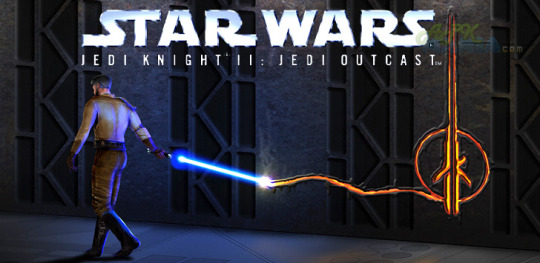
I grew up playing Jedi Knight: Jedi Outcast on the GameCube, the only game of the series that I had access to and I spent years craving the opportunity to play the sequel Jedi Academy. I played my favourite missions again and again; playing with and without cheats and played multi-player (against the computer) for hours at a time. I still remember convincing my friend to play with me, only for him to win using cheap exploits. He won, but I don’t think it was fun for either of us.
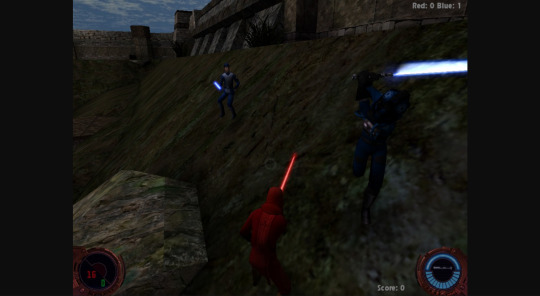
-above: multiplayer
I was so obsessed that I would devour whatever information I could find on the next game, and I believe this was before Let’s Plays on YouTube were a big thing. I learned that you could design a character AND a lightsaber; could you tick ANY more of my boxes? I even downloaded a PC demo to, well let’s be honest here, fail at. It would be a long time before I started playing games on PC and that may be due to my experience with this demo. I knew enough about this game that I could call out a braggard at school; you know the type, that guy who has played everything you want to play and is cooler than you until you realise that he doesn’t know jack-all about what he’s talking about.
When I finally started playing games on PC, I discovered that I had access to this series; in fact I think Jedi Academy was the deciding factor on why I started doing so. I found that the early games were too clumsy for a casual gamer like myself to play, although I was able to finish, and then cheat my way to different lightsabers and realistic dismemberment, that game from my childhood dreams. I love the series so much, and particularly the main character, that I have decided to take the time to write this. I intend for this to be a summary of the series rather than a review and is totally, one-hundred percent for fun; for me and hopefully those who read it.
The first game was released in 1995 was a clone of Doom which had come out two years earlier, and the final game came out in 2003 so you can imagine the sort of thing that I am talking about.
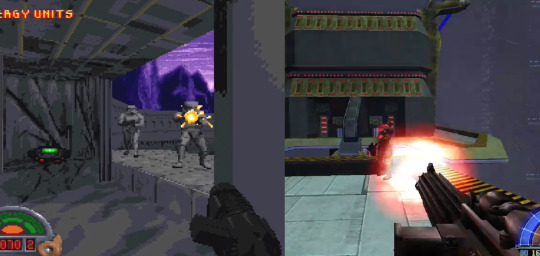
-above: graphics from the first and final games of the series
Despite being called the “Jedi Knight” series, that title only appeared from the second game onwards, which makes sense considering the first game was, as I said, a Doom shoot-‘em-up clone; it was only in the second game that the protagonist begins down the path of the Force. Speaking of whom, the series follows the character Kyle Katarn, an ex-Imperial officer who was betrayed by the Empire over the circumstances of his father’s death and became a mercenary with ties to the Rebel Alliance. Katarn and his games are not currently canon (by which I mean an official part of the Star Wars story) thanks to 2016’s Rogue One, given that the very first mission of the very first game is to steal the Death Star’s plans. Before the new entries to the Star Wars universe plodded over and trampled down what was the Extended Universe and is now referred to as Legends, Katarn was popular enough to appear in literature, graphic novels, role playing games and the video game Lethal Alliance.
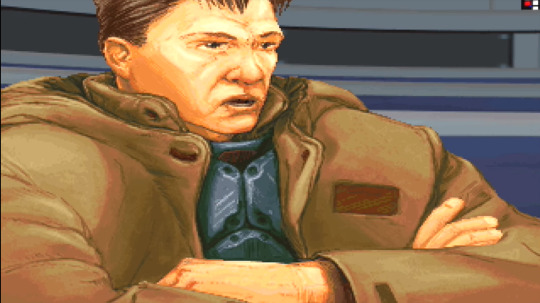
-above: Kyle Katarn in his first appearance
Bringing my wayward thoughts back on track, the first game (Star Wars: Dark Forces) involved a very, boring Katarn shooting his way through his given mission of stopping the Empire’s Dark Trooper project, all of which is set to happen after the first movie. Thankfully Katarn improves as a character (personality-wise AND physically) as the series does. The game is separated into different missions, each with its own objective and usually on a different planet to the last. There isn’t much of a story outside of how the main goal is accomplished, with no real character dynamics or establishing of their backgrounds.
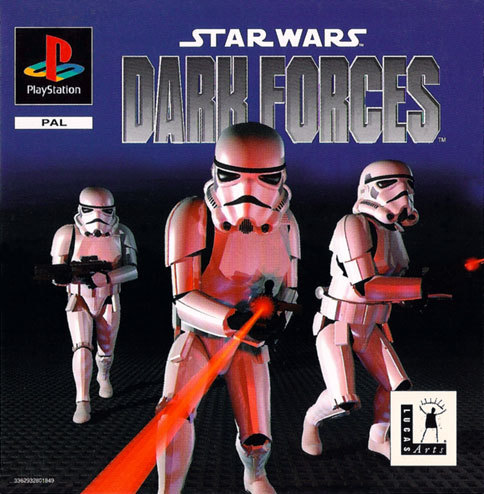
-above: the PlayStation cover for the game
The second game is called “Star Wars” with the subtitle “Jedi Knight” and… a second subtitle? I don’t get how this works but the game is known by the second subtitle “Dark Forces II” and I personally wouldn’t mind if the entire series was called Dark Forces which sounds badass; plus Dark Forces: Jedi Outcast is far less clumsy than Jedi Knight: Jedi Outcast, but hey. Getting, again, back on track, Dark Forces II was released in 1997, two years after the first.
The developers attempted to use live-action cutscenes to tell the story, bringing about an adorably quaint feeling through bad acting and even worse CGI. Katarn’s actor, Jason Court, was a major improvement on his design which would stick around for the rest of the series (in cases like this I always have to wonder what the actor thinks of the later representation of the character, if he cares at all).
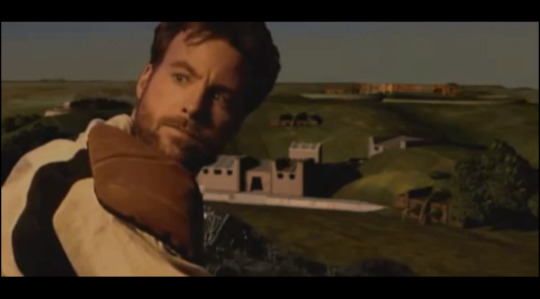
-above: Jason Court as Kyle Katarn
The story of Dark Forces II, set after the Battle of Endor, followed the pursuit of the Dark Jedi Jerec who is attempting to become the leader of a new Empire and who was revealed to be the killer of Kyle’s father. In a cutscene, Jerec kills Jedi Qu Rahn whose disembodied voice talks Kyle through the training needed to become a Jedi and who provides advice throughout the game, particularly before a boss fight. It is also Rahn’s green lightsaber that Kyle uses, and is his first out of three over the series. The rest of the story is pretty simple as Katarn chases down Jerec, all the way to a place called The Valley of the Jedi where a Force user can gain immense strength. The most interesting part of the story is how there are two endings: the Light side and the Dark side endings.
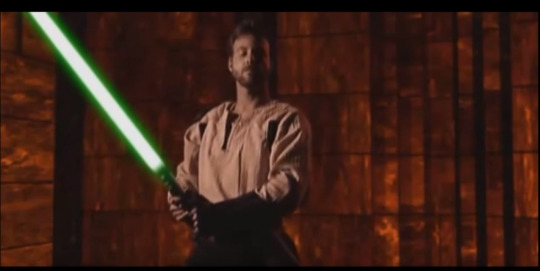
-above: Kyle with Qu Rahn’s lightsaber
The Light side ending is the canon (technically correct) ending where Katarn’s actions earn respect from one antagonist and whose yellow lightsaber becomes yours after Rahn’s is destroyed, and Katarn uses it to kill Jerec in the Valley. He eventually becomes a Jedi and trains with Luke Skywalker, although this isn’t established in-game. The Dark side ending has Katarn kill Jan Ors, the token love interest, and the voice of Qu Rahn stops talking completely, having abandoned you just as you did the Light side, and after killing Jerec, Kyle fulfils his goal for him, becoming the new Emperor with Jerec’s female companion alongside him, all the while retaining Qu Rahn’s green lightsaber.

-above left to right: The Light side and Dark side endings
There was an expansion pack named “Mysteries of the Sith”, where the player got the chance to play as Mara Jade (who has quite a presence in Legends) and fight Kyle who fell to the Dark side. Set five years after Dark Forces II, Kyle has become a Jedi Master and is still using the yellow lightsaber he gained while fighting Jerec. During his time as a Jedi, and clearly after this game, Katarn builds his own lightsaber, putting aside the yellow one in favour of this new blue one with a much cooler hilt (although if you’ll entertain me, I’d like to say I’d prefer that he kept the yellow blade after changing the hilt as I feel that blue lightsabers kinda oversaturate the Star Wars universe; either establish blue as the colour of the Jedi or mix things up to keep it interesting, please).
At some point before the third game, Jedi Outcast, Kyle’s fear of the Dark side is exacerbated by actually falling to it, and he separates himself from the Force and the Order, leaving his new lightsaber with Luke. During Jedi Outcast he returns to the Force when Jan Ors is kidnapped by Dark Jedi Desann (there are so many of these buggers), retrieving his lightsaber and relearning his powers. This game is a landmark in the series for the development of the unique and super-fun lightsaber combat system.
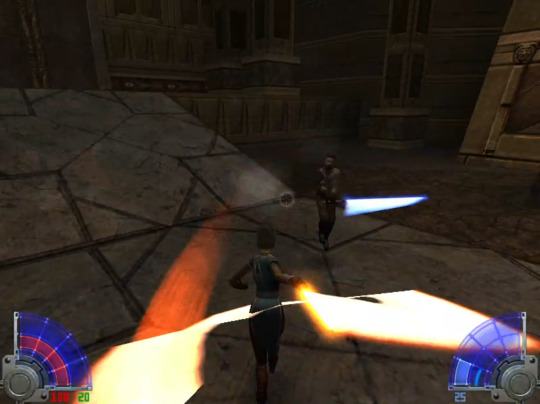
This combat system made use of the agility of the Jedi, leaping off of walls, somersaulting and wall running to get the upper hand in fights and the fights themselves can either really drag on, leaving the player with stiff hands, or end in a single strike, depending on a combination of skill and chance. This method of fighting earned the game a Lot of praise and is largely considered to be the best lightsaber combat system of all time and was expanded on in the next game, Jedi Academy, where dual wielding and double-ended lightsabers were added, each with their own styles.
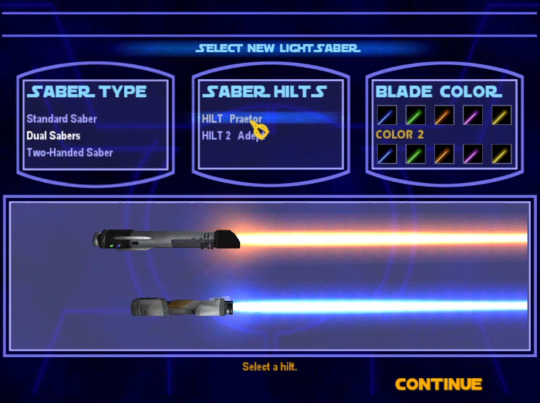
-above: mid-way through the game you can choose a new style
On top of this there were options to cheat, allowing the player to decapitate and dismember their opponents (or themselves should they lose in a fight) and thanks to these cheats, Jedi Academy gave players the opportunity to pick up dead opponent’s lightsabers and use them; this allows the player to switch between single, double and duel sided lightsabers depending on what enemies they face. It’s so incredibly cool that one has to wonder why it wasn’t a part of the game already, especially as they can be unlocked with a code in the console (I don’t understand this well enough to explain, but it's basically accessing what’s already in the game).

-above: a red lightsaber taken from dispatched enemy (not shown)
By the end of Jedi Outcast, Kyle has returned to the order and is an instructor during the events of Jedi Academy, the final game in the series. As Jedi Academy did really well upon release, yet it followed so soon after Jedi Outcast that some apparently considered it to be little more than an expansion and I assume there was some amount of Dark Forces exhaustion which may be why no further games were made. There may be other reasons, but they are not important for the purposes of this piece.
Dark Forces IV: Jedi Academy (see how it flows so much better when you don’t say “Jedi” twice?) no longer directly follows Kyle, but instead follows Jaden Korr, a character whose species, sex and overall appearance are designed by the character, although there does seem to be a canon design as the character is mentioned elsewhere. This could be considered disappointing, but neither species nor sex affects the story in any way so it is debatable whether or not this matters. I believe that I mentioned this in an earlier article but the customisation options are limited and, in some cases, kinda weird. Clothes are specific to species and sex, while not all races have both genders even if that has been established; for example you can only play as a female Twi'lek. I assume there is a reason for these choices, although the clothes limitation seems a bit odd and, should we ever be lucky enough to have this game remade, I’d hope that future editions expand on the options. (I’d like male Twi’leks and a Togruta species, plus outfits that aren’t limited to species).
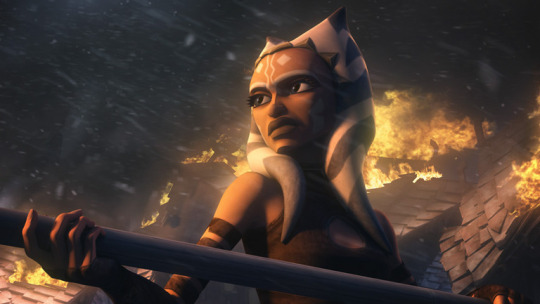
-above: Togruta female Ahsoka Tano from the Clone Wars cartoon
The same applies to the lightsaber customisation. The player is understandably limited to three types of lightsaber: a single blade, two blades or a double-ended saber, but the blade colours are limited and the hilt has to be chosen from a pre-made select few. With today’s technology it should be no problem to expand these options. I have rambled on a lot about customisation as I always find it to be a favourite part of any game, but I’ll get back on track now.
The story of Jedi Academy follows Jaden Korr, fellow disciple Rosh Penin (an absolute tool) and their master Kyle Katarn. While Kyle is technically training these two, Jaden is usually alone in their missions. Rosh slides to the Dark side as Jaden uncovers a plot to steal Force energy from particularly powerful places (what the hell even is the Force anyway? I might write a thought piece about that sometime). We discover that the perpetrator is a character who Kyle let live from the last game and Jaden can lean into either the Light or Dark side for a different ending, just like Dark Forces II, but the Dark side ending (also non-canon) pits Jaden against Kyle in a final battle.

-above: failing the final battle against Kyle (I did this a lot)
I don’t know how to conclude what is meant to be a simple summary of a series and doing so is probably made harder by the fact that I’ve already written about it from the point of view of how it could be remade.
The Star Wars: Jedi Knight: Dark Forces series is an amazing product unfortunately limited by its time. Of course I wouldn’t want it delayed to be made later as the same people wouldn’t be working on it with the same goals and intent; it simply wouldn’t be the same series.
5 notes
·
View notes
Text
Word Vomit Wednesday - Stop Kavanaugh
Welcome to Word Vomit Wednesday! A series of blog posts where I attempt to process thoughts and feelings, usually about a specific topic from current events that I, and sometimes the rest of the Internet, ruminate obsessively about. All thoughts/opinions/experiences are my own (unless otherwise indicated); I don’t claim anything that I write to represent anyone other than myself.
CW: Sexual Assault
As with pretty much all the news about our current state of affairs, the Kavanaugh nomination and hearings for SCOTUS have been extremely triggering and stressful. Even before Professor Christine Blasey Ford came forward with her story of being sexually assaulted by Kavanaugh, this nomination indicated an even darker America to come, as if the one we’re in now isn’t dire enough for women, the LGBTQ+ community, and BIPOC. And, as with so much of the news we’ve been contending with since 2016, I’ve felt a need to pull back from watching it, reading tweets and articles almost ritualistically just so I can take care of myself physically, emotionally, and psychologically. Staying on top of everything going on takes a tremendous toll and I constantly find myself thinking about how the well-beings of marginalized people are constantly looked over and dismissed.
This came up for me again the other night when, after having a pretty relaxed evening watching The Emmy’s with my parents, my dad turned the news back on and that sense of simmering rage and hypervigilance that I’ve learned to just deal with existing as a woman in the world, came bubbling right to the surface. I had to leave almost immediately because that was not the way I wanted to end my day feeling. If I’m going to be active and helpful in any way, even in small ways like writing this blog, I need to be able to sleep at night. But one thing that came up in the few minutes of watching the Kavanaugh coverage that I have not been able to stop thinking about was a quote from someone in the nominee’s camp saying something along the lines of not even knowing the story or who the woman could possibly have been until Ford revealed herself. This narrative is offered over and over again as a way to dismiss women when they come forward in these situations. A narrative that continues to portray women and our experiences as insignificant.
That killed me. The fact that this woman not only went through a trauma where her personhood was never considered from the get-go, has been affected by it for decades, is risking her life for this country (she and her family have since had to leave their home due to death threats) to share her story and make her identity known, to again, be told by men she is not worthy of consideration is devastating. And that seems to be a major key in all of this. Women are not considered. At all. Kavanaugh probably didn’t recall the assault because he got what he wanted out of it. He never considered Ford or her feelings, needs, or wants. He couldn't have cared less. He still couldn’t care less. The GOP, who should care about putting an alleged rapist on the bench of the highest court in the land, but instead made a publicity stunt of having 65 women sign a document (all but two seemingly had no idea what they had signed) that stated they would vouch for Kavanaugh, definitely don’t see a problem if they’re willing to manipulate women to get their man through the confirmation process.
I saw a tweet the other day from @laurenthehough, who shared this sentiment: “You know what would be fucking weird to hear? ‘I did that. It was fucking terrible. I’m sorry. I did years of therapy and soul searching and work and I changed my behavior. I can’t change what I did. But I made damn sure I never did it again.’ Why is that never the statement?”
Why is that never the statement? I cannot tell you how healing it would be if those were the statements that we started hearing. Real accountability. Real apologies. Real work put into an individual’s growth and education. Would those statements start solving all of these problems? No, of course not. But they would at least indicate that these people recognize that the women they’ve hurt are people. And that they understand that they have caused harm, sometimes a lifetime’s worth, to another person. That would create a powerful shift. Because one of the reasons we don’t hear these statements is because these people don’t consider what they do to women to be of any significance. That unless you’re related to a woman by blood or marriage or if you find them attractive, they don’t matter. It’s probably inconceivable to Kavanaugh and his ilk that a situation that was so forgettable for him because “boys will be boys,” had been burned into Ford’s mind. She never mattered to him, he felt entitled to her and her body, and our culture allowed that.
As I’m writing this, I realize that I will be posting it on arguably the most important Jewish holiday of the year, Yom Kippur. Which couldn’t be more fitting for this topic. Yom Kippur translates to Day of Atonement. It comes ten days after Rosh Hashana, the Jewish New Year, wherein those ten days are meant to give us time to reflect on the past year. All the great and terrible experiences and the things we wish we did better or hadn’t done at all. What we are sorry about and who we need to apologize to and when Yom Kippur finally arrives we are supposed to take full accountability for ourselves. Now, one day to hold ourselves accountable for our actions (as well as inactions) and how they’ve caused harm and suffering to others and actively make amends is not enough. Especially if the damage we have caused has had a prolonged traumatizing effect on person’s life and livelihood. Going to shul once a year and reciting prayers are not going to fix things or provide the healing that’s actually necessary. But at least the holiday is there to jumpstart the conversation. To hopefully get us thinking outside of ourselves and give the apologies that we wished we’d been given when we’ve been wronged and make necessary and lasting changes.
I’m pretty sure Brett Kavanaugh is not Jewish, probably has no idea what Yom Kippur is, and, like most cis-het white males, doesn’t think he's done anything wrong and that he's entitled to whatever the fuck he wants. But for those men who do genuinely want to make amends and be better people and because we very rarely have a framework for how to get started with that, I’m going to offer a few suggestions (mostly for men to combat rape culture and inequality, though some of these skills definitely apply in many other areas and for most people) on some things to start focusing on that would be incredibly helpful. This is by no means a complete and comprehensive list, and there is no significance to the order, but a few things to get people started.
Listen to women and believe them. We know our own experiences, so please do not come at us with “what if she’s lying” bullshit. There’s a reason men are conditioned to believe that women are liars and that reason is to keep women oppressed. Learning how to listen, really listen, is one of the most valuable lessons anyone can learn. When you check your egos at the door, unlearn your social conditioning, and learn to center and hold space for someone else and their feelings, especially when they’re in need, it validates their humanity. We all need support and knowing someone is in our corner who’s not going to question our motives, interrupt us as we process whatever we’re going through in the moment, or lash out at us is basic common decency that we are rarely shown, but (as women) are expected to provide for others. It’s also invaluable for the listener because you will get to understand someone else’s world a little better and hopefully gain more perspective on the one you inhabit.
Start asking “What do you need” and “How can I help you.” Practice those questions so much until they become second nature. No one is asking you to bend over backwards for other people, only you know what your limits are and it’s your responsibility to be honest about what you can or cannot do, but this is another small gesture, just like listening, that goes a long way. On the flip side of that, asking for help when you’re struggling is an important skill as well. People will typically show up for you if you give them a chance, especially if you’ve shown up for them.
Hold other men exhibiting toxic behavior accountable. Show by example how a good man acts and let those who are extremely problematic know that you see them and what they're doing and are not here for it. Men listen to other men (bc toxic masculinity, but that’s a post for another day), so you pointing out that some behavior or thought-pattern is problematic or shameful is effective.
Vote for and support women. Not just the ones you’re related to or find attractive. If you can only make room for the former, you're only performing ally ship and you don’t actually support women.
Men built the glass ceiling, therefore it’s your job to dismantle it. Do not put the extra weight of men’s work on marginalized folx who are already carrying and navigating too much.
Go inward and start tackling your own internalized patriarchal proclivities. Do your due diligence to understand toxic masculinity, sexist/racist double standards, and your privilege and the ways in which you help perpetuate a system that gives you benefits at the expense and suffering of others. Ways to start doing that: go to therapy, get a group of your boys together and actually start talking about and identifying your feelings and asking each other questions, read books or watch films/tv by people who come from very different backgrounds than you. You’ll hopefully learn a lot about yourself and the world. And you’ll learn how to take responsibility for your own feelings in a healthier way, rather than putting and projecting that emotional labor on the women and other marginalized folx in your lives.
If you have realized that you have done something wrong or hurtful or it was brought to your attention that you have, you may want to get defensive. Acknowledge the feelings you're having to yourself, but to the appropriate parties try saying something like this: “I did that. It was fucking terrible. I’m sorry. I did years of therapy and soul searching and work and I changed my behavior. I can’t change what I did. But I made damn sure I never did it again.” If you haven’t done the work yet, don’t say you have unless you do actually plan on following through. And then follow through. These are also great growth opportunities for utilizing those new listening and offering assistance tools from #s 1 and 2.
*BONUS*: Do not, under any circumstances, attempt ANY of the above with ulterior motives. You do not get a gold star for being a “good guy.” This is just how people should be treated. Decently, respectfully, and without any expectation of owing you anything in return.
Obviously, this is a very simplified list but when you start opening the door to one of these items, more and more doors begin to appear. As hard as it may be at times, it is worthwhile work that benefits everyone. Also, if you’ve made it this far, please call your senators and tell them to not confirm Kavanaugh to SCOTUS. We, the people, deserve someone on the bench who considers all of us.
Katie Louchheim seriously doesn’t know how she functions on a daily basis with all this bullshit. CALL YOUR SENATORS TO #StopKavanaugh: 202-224-3121.
1 note
·
View note
Text
Vidja Games
So I checked out Game Informer’s list of the top 300 greatest video games, and they are objectively wrong, lol (I can’t imagine the fights that went into making this list??)!
I’m no critic, and I’m not interested in attempting to objectively rate games, but here are my (subjective) faves in rough order-ish, if you’re interested! They are arranged by franchise for my sanity below the cut.
The Elder Scrolls (TES)
My all time favorite video game series is TES, although I wasn’t able to stomach playing I and II. In order, my favorites are: Morrowind, then Oblivion, then Skyrim.
Morrowind is unfriendly to casual gamers, and even experienced folks need to learn the lay of the enormous world, how to fast travel, and even how to level and plan characters to best effect. The learning curve is enormous, and if you decide to play a different type of character later on, you’re stuck! You might even have to start over, since you level your character by increasing the major and minor skills you chose upfront.
But I have never experienced such an open, imaginative world. The later installments felt both smaller and less varied. In Morrowind, you’ll find everything from sprawling floating cities to houses built into enormous mushrooms, with ashlands, swamps, and mountainous terrains in between, complete with hell-on-earth smack-dab in the middle of everything.
Oblivion is more user-friendly than Morrowind, and it has some of the most engaging quests in the series. What it loses in environmental diversity and sheer exploration potential, it almost- almost- compensates for in fun quests (there’s much less ‘fetch me some swamp muck’ involved), easier transportation, and the wonderful world of Shivering Isles, an expansion.
Skyrim is the most accessible of the three by far, and it’s forgiving in that it allows players to change their play style on the fly with little repercussions. It also has the best combat. Sadly, the repetitive environments make it far less compelling to explore than its predecessors, which is a huge part of TES’s charm for me. I also found the enemies repetitive. The more fanciful enemies are almost absent, and the few that exist are tied to specific daedric quest lines. Do you know how hard it is to recharge enchanted items when you only encounter a handful of daedra? Wolves and trolls just don’t fill them back up well.
Also, while the accessibility widens the target audience considerably, it cuts into the customization options previously available to more experienced gamers. That was a huge disappointment for me, personally.
To be clear, though, I still adore Skyrim.
Personal anecdote: My Morrowind strategy book was so worn that it fell apart, so I punched holes in the pages and kept it in a binder. I took out the fast travel map and the local map of whatever area I was combing to find a dungeon door tucked into a cave hidden behind ivy or whatever. I still have it; it’s a sentimental treasure.
The Sims
The more open-ended a game is, the more I like it, and The Sims is king of that arena! For me, 3 is by far the best installment. 2 introduced the idea of having types of Sims with personal goals to meet to create direction for the player, but ultimately, it felt like I was stuck with the same five Sims over and over again. The wishes and moodlet system of 3, along with the five slots for personality traits, gave me so much more power to create Sims that felt like actual characters.
I... don’t even want to know how much of my life I’ve put into The Sims...
My ranking: 3>1>2>4
It should be noted that I didn’t mind 1′s lack of direction, since my imagination alone is way more than enough to pull me forward in a sandbox game. In comparison, 2 felt restrictive by creating five character types, limiting me to that in a way I couldn’t ignore.
Personal anecdote: I received the original Sims for Christmas when I was in middle school. I accidentally played from bed time until 4 AM, which is the closest I’ve ever come to pulling an all-nighter.
Sonic the Hedgehog
WHERE DO I EVEN START WITH THE BLUE BLUR.
Sonic was an enormous part of my childhood, guys. I played all the games. I watched both cartoons (the one with Sally and the Freedom Fighters and the one where it’s just Sonic/Tails/Eggman/some robots), I learned to read with the comic books. I have a vivid memory of my brother taunting me by refusing to let me see his comics “because I couldn’t read”... So I spite-learned using the comics when he wasn’t paying attention.
I don’t think I can pick a favorite! As a kid, I played Sonic 3 the most; I was a huge Knuckles fan, so that might have played a role (also the original Sonic was too difficult for me at the time, although I certainly tried). But I also loooooved Sonic Adventure and Sonic Adventure 2. And Sonic Generations was so much fun!
Mario Bros
Lord, I was playing Mario games before I could read, I don’t... Mario has always been around for me, okay? It’s a huge part of my story, and the franchise is so iconic that there’s little for me to say. There are way too many amazing games in this franchise for me to name, but personal faves include: Super Mario RPG, Super Mario World, and Yoshi’s Island.
The Legend of Zelda
This is another franchise where I don’t know what to say... It’s too iconic for me to offer much. Zelda games are known for their exploration and adventure, even from the beginning. Ocarina of Time was a big part of my childhood, but I also adore the newest installment, Breath of the Wild. And I know this may be silly, but I love Hyrule Warriors! I can’t wait to play it on the Switch with all the DLC.
And the music??? Guys????? THE MUSIC?!?!?!
Bioshock
Amazing atmosphere, fun game play, and one of the best stories in gaming history add up to an unforgettable experience. Also a fore-runner to the idea of playing dialogue and recordings while the player explores, a trend that caught on in a huuuge way.
Persona
It’s hard to describe Persona games... They basically combine Jungian psychology with various mythologies, sprinkle in some horror (or glob it on in the case of 3), throw in an RPG, and add a heaping serving of everyday high school life. The games tackle a wide range of ideas and game play, creating a unique experience that has drawn a devoted following.
I’ll make this quick:
3: Best story and atmosphere, worst/most needlessly frustrating game play, very prickly cast lol
4: Best characters and character development
5: Best game play (exquisitely polished game play, really), best overall style, worst story and character development
My ranking is 4>3>5. It should probably be noted that story and character are king for me, so while 5 was incredibly polished mechanics wise, the comparatively weak story and characters sunk it to the bottom of the list for me. It was one of those games where I understood where they were going hours ahead of time, and then they would explain “the twist” to the player for half an hour over and over and over. Frankly, it was... kind of insulting, and soured the experience for me.
Also, Mona, I swear to god, how am I supposed to pass school if you don’t let me study or do my homework because you think I need to sleep at 5 PM every day ahhhhh! XD
Harvest Moon
Oh god, here’s another franchise I don’t want to delve into in terms of hours I’ve spent playing O_O
I can’t even explain why I like these games... In HM, you are a farmer, and your job is usually to prove to the villagers that you’re a valuable member of society so that they won’t evict you from your own inherited property. (I’m curious about their deeds and legal policies, lol. How do you write that clause up?).
These games combine farming with socialization and light dating sim elements, and time management is the name of the game. They pull in players by tapping into the universal desire to create order and advancement.
My favorite installment is Friends of Mineral Town. I also adored Harvest Moon 64, but the controls are sadly too dated for me to replay it.
Pokemon
I’m sure I’ve missed at least one, but I’ve played almost every mainstream release of Pokemon since Red and Blue came out. It must be doing something right, lol!
I’m a huge sucker for games where you choose monsters to raise. It’s so fun to assemble a team based on your tastes and raise them just so!
My favorite release is the remake of Gold and Silver.
Monster Rancher 2
OH MY LORD I played this game to the point where I’m shocked the disc still works. In Monster Rancher 2, you find monsters by placing discs into your Play Station, which each encode a monster. In order to access the strongest monsters, you must raise your rank as a trainer by winning official tournaments.
I wish I could explain why I latched on to this particular game so hard, but... I think it had something to do with the massive variety of monsters, the difficulty of the tournaments (I never did hit S rank, and not for lack of trying!), and the myriad of odd ways to unlock special monsters.
Mario Kart
Seriously, who doesn’t like smiting friends and family on the race track? MK is a fun, family-friendly way to deliver a beat down... As long as you contain your desire to cuss like a sailor, anyway.
It’s so hard to pick a favorite here! It’s hard to top the original for the challenge... But Double Dash and Infinity are contenders, too.
Danganronpa
Danganronpa games are visual novels that mix survival, horror, and crime-solving into a dark, bizarre, unique experience. I’ve written a ton about this series lately, so I won’t delve into it here, but you can check out the danganronpa tag on my blog for more.
Kingdom Hearts
These games are so charming and fun to play! I’ve never completed one on my own- linear games are rough for me- but I’ve seen my husband play them all, even the (many) extra installments. KH2 is probably my favorite, although Birth by Sleep was amazing, too.
Final Fantasy
I’ll admit that I don’t really enjoy playing Japanese RPGs; linear gameplay doesn’t appeal to me much in general. But the FF franchise is famous for its sweeping narratives, imaginative environments, and breath-taking music, and I enjoy them for that. I’ve watched my husband play X-XV, and I briefly joined him in playing XI and XIV. My favorite is probably X... Although I have an enormous crush on Ignis from XV.
My favorite FF game to play is Theaterhythm: Curtain Call.
Mass Effect
How do I say this... I don’t think I’ve ever played a game that better simulated becoming an entire universe’s hero and moral center. In Mass Effect, you shape the world and the political climate in unprecedented ways. By the end of 3, every player is so deeply invested in their Shepard and the world s/he created. In that sense, it’s en epic experience without peer.
Destiny
I love playing Destiny with my husband and our friend! I’m a titan, Tony is a hunter, and our buddy is a warlock, and together, we are... three guardians, lol!
Okay, so the vanilla Destiny release needed some help, but it became a great game with the expansions. I’m still waiting for that breath of rejuvenation for 2, but I treasure the time we spend together kicking ass as a team.
Left 4 Dead
This game redefined what co-op meant to me. I always thought of it as Halo, basically competing on the same team against other players. And yeah, you do that in L4D... But the cooperation angle that this game brought to the table was more or less unprecedented.
In L4D, if your team of ragtag survivors doesn’t work together, it’s unlikely that anyone will survive. I spent a lot of free time in college playing this with my friends spread out over different schools. I had so, so much fun with it.
Although 2 had more varied game play, which was great, I enjoyed the original more, mostly because the online game play wasn’t as loaded in favor of the zombie team. Objectively speaking, though, the sequel was the more robust game.
Personal anecdote: L4D is where I learned about dealing with males online. With Halo, which I also played at the time, I only enjoyed it enough to play it with people I knew. I loved L4D so much that I would log in to play even when my friends weren’t available, which meant that I was teamed with random players.
I have a very feminine voice, which apparently means that I am meant to be treated like crap online. Even though it’s a co-op game, and communication is important, I spent most of my sessions with the headset turned off.
Borderlands
THIS GAME, I HAD SO MUCH FUN WITH IT! The crass humor, the expanse of wastelands, the gun-slinging insanity, the incredible couch co-op! What’s not to love?
Sadly, the sequel was a downgrade from the original, but the first game was an amazing ride. I’ve been considering replaying it with Tony with all of the DLC.
Metal Gear
I’ve never played these myself, but I watched my husband play the first three. They’re so cinematic and goofy and over-the-top and awesome! I love breaking out my Solid Snake gravel voice, too. My favorite is... probably 3? It’s hard to pick between 2 and 3, though...
Disgaea
Hmm... How to describe these games... They’re tactics games, I guess? And there’s a lot of story, too... Game play wise, the later installments perfect what the earlier ones started, but you can’t beat the story and characters of the original. Laharl is still one of my all-time favorite male video game characters. He’s... such a brat? I love him???
Honorable mentions in no order (ie, I’m tired of writing descriptions, sorry to the rest of these games):
Halo, Dragon Age, Fallout 3, Ratchet & Clank, Resident Evil, Portal, Soul Calibur, Tetris Attack, Uncharted, Ms. Pacman, the Batman Arkham games
EDIT: I forgot Nier: Automata and Super Smash Bros! FOR SHAME!
2 notes
·
View notes
Text
The RPGs of the Super NES Classic #2: Super Mario RPG - Legend of the Seven Stars
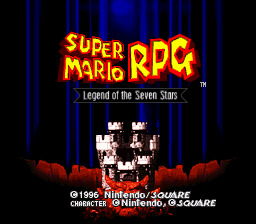
Original Release Date: March 9, 1996 (JPN)
Original Hardware: Nintendo Super Famicom
Developer/Publisher: Square/Nintendo
There was a time where the idea of Mario being in a role-playing game was absolutely bizarre. Now that Mario's had several turns at the genre it's not nearly as outlandish a concept, but just about everyone I knew who was into games at the time was quite surprised by the mere existence of Super Mario RPG. Looking at it from a Japanese perspective, it's not that strange, I suppose. RPGs were hot, parody RPGs were already a thing, and Mario wasn't any more out of place than Doraemon or Godzilla. In the West, though, things were different. Console RPGs were about to break out on the back of an incredible marketing campaign from Sony for Final Fantasy 7 and the meteoric success of Pokemon, but they weren't there yet. The ones we did get typically fell into the fantasy genre, with the odd science-fiction game to mix things up. The best-known console RPGs were heavy on melodrama and usually played things reasonably straight. So yes, the news of the Final Fantasy folks making an RPG starring Nintendo's mascot kind of came out of nowhere.
Super Mario RPG represented the culmination of what was seen as one of Nintendo's closest relationships with a third party. Square had been peddling their wares almost exclusively on Nintendo's hardware for quite some time to great success. From Nintendo's perspective, having both of the major RPG publishers in Japan on their platforms exclusively was a real boon, and Nintendo had even gone so far as to publish Final Fantasy overseas to try to get it off the ground in the West, just as they had tried to do with Dragon Quest. It was in pursuit of that Western success that Super Mario RPG was born. Square had been trying hard to get the Western console audience to bite on RPGs the way their Japanese counterparts had. They pushed the Final Fantasy brand as widely as was possible for a company of their means, made a spin-off that served as a beginner RPG, and even tried setting up an American development team. Perhaps what they needed, it was surmised, was an established star. For Nintendo's part, Shigeru Miyamoto had apparently been interested in seeing Mario star in an RPG. The deal was made and Super Mario RPG entered development early in 1995.

Sadly, this game would prove to be the last collaboration between Nintendo and Square for quite some time. Scant months before the official release of Super Mario RPG, Square made the announcement that changed the entire video game landscape in Japan and arguably the world. Final Fantasy 7 would be their most ambitious project yet, and it was coming exclusively to Sony's new PlayStation platform rather than Nintendo's Nintendo 64. To say Nintendo's president, Hiroshi Yamauchi, did not take this announcement well would be an understatement of the highest order. It would be several years before Nintendo and Square would mend fences and do business together again. What should have been a celebration of a great on-going business relationship ended up being its eulogy instead.
While Super Mario RPG wasn't exactly the game to break down the JRPG walls in the West, it did do fairly well for itself considering how late it released in the Super NES's life cycle. It turned out that with some careful considerations, Mario was a really great fit for a light-hearted RPG that would appeal more widely than the usual game in the genre. Of course, with the relationship soured with Square, Nintendo went in a very different direction for their next RPG starring Mario. Intelligent Systems drew some ideas from Super Mario RPG for their Paper Mario RPG on the Nintendo 64, but it was very much its own thing on the whole. Meanwhile, several former Square employees, many of whom had worked on Super Mario RPG, set up their own new studio called AlphaDream in 2000. Headed by Square's former president Tetsuo Mizuno, the team self-published just one game before beginning a long-term second-party relationship with Nintendo, the greatest fruits of which being the Mario & Luigi series of RPGs.

For a lot of English gamers, Super Mario RPG was their first experience with Japanese RPGs or even RPGs in general. I've noticed there is a lot of affection for the game and its characters, with many of its fans believing that the Mario RPGs never got better than this. I can appreciate that perspective, but I'm not sure that I'd agree with it. The game was attempting a very unusual hybrid of mechanics and themes, and it doesn't always work out for the best. As we would similarly see in the later Kingdom Hearts series, there's a little bit too much Square in here at times. By that I mean the game occasionally feels decidedly unlike Mario, sliding into odd bouts of melodrama and opting for a slightly darker tone than we would see in later Mario RPGs. The pacing is a little hit-or-miss, too. That all being said, I have tremendous respect for this game simply for being largely successful at navigating the tumultuous waters of mixing a beloved side-scrolling action mascot and his world with turn-based battles and leveling up.
Outside of battles, the game didn't do anything particularly unusual by action-RPG standards. The game takes on an isometric perspective and involves a fair bit of platforming and navigational puzzles. These are all things we've seen before, even among the limited selection of games I've covered on this very site. The angled view of the action can make things somewhat tricky as usual, but Super Mario RPG is wise enough not to ask too much of the player in this regard. Anything truly maddening is relegated to optional content, ensuring that even a moderately-skilled player will be able to see the story through. Battles take place in a separate screen, and basically follow the turn-based rules of games like Dragon Quest or earlier Final Fantasy titles. The big innovation here was in including timing-based commands that, if successfully performed, could increase the amount of damage you deal to enemies or reduce the damage you take.
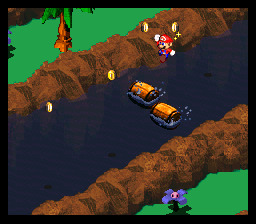
It was a smart way to bring a little bit of familiarity to a situation foreign to action game fans. Sure, you had to pick what Mario was going to do from a menu, but when he leaps into the air to jump on an enemy's head, carefully-timed button presses will allow him to bounce off of his foe's head and keep on going, just like in the platform games. This semi-action based combat would become the hallmark of Mario RPGs, with increasingly complicated mini-games introduced as time went on. Aside from pulling some of the action elements from the platformers into the game, these commands also kept the players fingers busy during battles. For players turned off by how hands-off many RPGs tended to be, this was a welcome element.
There's something else I have to give Super Mario RPG credit for, too. Namely, this is the game that started to flesh out Mario's world and the characters who inhabit it. This game was Princess Peach's second playable appearance in a non-sports game, and the first playable appearance of Mario's frequent foil, Bowser Koopa. The villainous king of the Koopas had never been presented as anything other than a nefarious bad guy before this game. Here, we saw a somewhat-likable oaf who was more egotistical than evil. This would eventually lead to Koopa starring in his own RPG in the third Mario & Luigi game, and certainly did a lot to endear the character to players. Mario's party is rounded out by new characters Mallow and Geno, who seem to have gone over a lot better with players in general than they did with me.
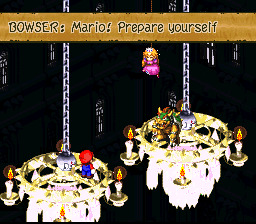
Beyond the playable cast, we also got a lot of world-building that allowed us to see the Mushroom Kingdom and other locales in ways we hadn't before. A village of Toads, the resident staff of Peach's castle, and even seeing Koopa interact with his henchmen all helped contextualize the platformers we had been playing for years. The game also features numerous nods to other Nintendo properties, to an extent that no other Nintendo title had done before. Do Samus and Link exist in the same universe as Mario? Smash eventually tells us that they sort of do, somehow, but it's first suggested in Super Mario RPG. Sure, it's just a bit of silly fun, but it was neat if you were a fan of Nintendo's wider world of releases.
My own experience with this game is somewhat strange. I bought the game the day it released for just over $100 Canadian, a typical price for Super NES games at the time. I blasted through the game over a three-day weekend, and having little desire to replay it, sold it on to a friend for $95. I was already a big fan of Japanese RPGs by this point, and I found Super Mario RPG to be a little too lightweight for my liking. To be fair, it was following a stretch of RPG releases that included Final Fantasy 6 and Chrono Trigger. There was only so much it could do. To be honest, very little of the game stuck with me at all. I first replayed it a few years ago when it got released on the Wii Virtual Console. It's a little clunky, and the art really hasn't aged well at all, but the core gameplay is solid enough. It's simultaneously more in some ways and less in others compared to the later Mario & Luigi games.
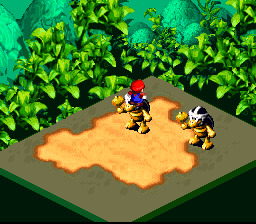
The game doesn't quite have its tone properly set, for one thing. It feels torn between trying to reconcile the silly nature of Mario's universe with an actual RPG-length plot. Later games in the series would pull back somewhat on trying to develop characters, instead opting for a greater emphasis on events and comedy to stretch things out. That gives Super Mario RPG a feel quite unlike other Mario RPGs, if nothing else. It also feels less confident in venturing too far outside of RPG norms in some ways. The various party members feel in a mechanical sense like the usual templates, something future games would expend a lot of effort to break away from. Still, there's some comfort in Super Mario RPG's embrace of the familiar. I'm not sure if this makes much sense, but if I'm in the mood for an RPG, this game does the job better than the later Mario RPGs in spite of their generally higher quality.
Given its slightly complicated rights issues (the game contains some Final Fantasy music among other bits), I'm glad that Nintendo has made it somewhat readily available through multiple Virtual Console releases and its inclusion in the Super NES Classic. While I don't think of it as highly as some others, it is one of the better Super NES RPGs to get an English translation. It's still a lot of fun, and trying to play the original game on today's TVs can be tough due to latency issues interfering with the timing of battle commands. I suspect that so long as things remain friendly between Square and Nintendo, Super Mario RPG should continue to see releases wherever Nintendo opts to plumb their back library. I only wish it had seen a Virtual Console release on the New Nintendo 3DS so that we could have the whole Mario (& Luigi) RPG series playable on a single console.
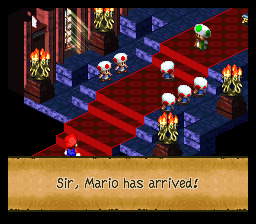
Previous: Final Fantasy 3
Next: Secret of Mana
If you enjoyed reading this article and can’t wait to get more, consider subscribing to the Post Game Content Patreon. Just $1/month gets you early access to articles like this one, exclusive extra posts, and my undying thanks.
#retro#gaming#super nes classic edition#rpg#jrpg#super mario rpg#mario#nintendo#square#super nes#snes
1 note
·
View note
Text
How much does a gaming laptop cost
Recommendations For Starting A Gaming Blog
Twitter is where game publishers, the gaming media, well known game streamers and entertainers, esports leagues, teams, players and commentators interact with their most engaged fans and with 1 one more. So what's with the lack of inclusion in the gaming planet? In addition to the usually hostile globe of desktop and console games (see the GamerGate controversy as just one particular example), there's still somewhat of an sector perception that women basically never play video games. But, that's far from accurate - girls are actually gaming far more than ever before, particularly on mobile.
Definitely glad that my weblog inspired you to start your own. Yes it's challenging operate and it requires some time to develop, but if you do it appropriately you can have a terrific on the internet brand. Starting the blog is only the beginning, so make confident to study the rest of my articles in the Gaming Blog Series which will take you by way of all the steps. If you have any queries don't hesitate to ask me, I'm delighted to assist exactly where I can.
Oh dear lord, to answer this question I had to stop myself from cheating and counting one particular of the stories I wrote in the previous. My greatest hobby, in addition to gaming and acting, is writing. Just before I began writing this blog, I made use of to create a lot of fantasy stories on paper. I have a couple of binders complete with story ideas and pitches for fairly exciting stories.
I got into action games late but when I did it fully changed how I viewed gaming forever. The game which brought me round was Viewtiful Joe. Right here was a game with a deep and open-ended combat method which seemed to be built as a indicates for the player to express creativity. This system is then pitted against opponents and obstacles which were developed from the ground up to interact meaningfully with the core method. The course was fixed, but the process for dealing with that course was entirely down to the ingenuity, talent and inspiration of the player. You play like you have a huge audience watching and the game continually entices you to increase the concentrate is not just on getting the player from A to B, the concentrate is on having the player to play Viewtifully”.
Kingmaking is a board gaming term for when a player who has no possibility of winning, deliberately utilizes his influence in the game to figure out the winner. The kingmaking player slows the player in the lead and or boosts another player to make a decision who wins the game. Kingmaking is frowned upon mainly because the outcome of the game is no longer by every single players skill levels or decision making.
Microsoft — with our nearly 40 years of gaming knowledge starting with Computer, as effectively as our breadth and depth of capabilities from software to hardware and deep knowledge of getting a platform corporation — is properly equipped to address the complicated challenge of cloud game-streaming. With datacenters in 54 Azure regions and solutions out there in 140 countries, Azure has the scale to provide a good gaming expertise for players worldwide, regardless of their place.
How To Use CONTEST To Ask
youtube
Paul: Our business enterprise model is growth focused and we cover three important places in the gaming industry. Firstly, we're a global e-Commerce store promoting over 7,500 games from 450 publishers in over 190 countries to millions of gamers. Secondly, Green Man Gaming has a thriving neighborhood who go over and track their oritong Mobile gaming blog game achievements on our neighborhood platform. This information combined with the commercial information of the shop offers Green Man Gaming a substantial depth of understanding of our consumers. Finally, we have a publishing arm that assists developers publish their personal games and bring them to industry, supporting them every single step of the way. The fusion of Green Man Gaming's e-Commerce retailer, a strong neighborhood creating billions of data points and publisher help sets us apart from our competition.

Designed for generating social networking web-sites for gaming communities, Blackfyre provides a wide variety of capabilities to enable you build exclusive clan web sites, gaming groups, content sharing web-sites, discussion channels and additional. Alongside a hugely efficient user account creation and management technique, Blackfyre also supports Clan creation to help your users to make numerous plans for their games.
Avantura has 1 of the very best developing blocks we've noticed for constructing a gaming web site, it supports special colour categories ( a should for any critical gaming magazine), can be combined with well known widgets, can be colour customized per web page, has many selections for the header and footer and it has an incredible good seeking blog post style. Also, it has a extremely good about the author module and some nice next and previous article hooks. On top of it all, it supports a good mega menu with images.
Gaming content material remains 1 of finest methods to reach young males. Tubular Labs reports that amongst millennial males, gaming— especially, gameplay— ranks in the major three categories for each 18—24-year-olds (#1) and 25—34-year-olds (#2). But what about girls? As it turns out, adult women have not too long ago unseated teenage boys as the largest video game— playing demographic, according to the Entertainment Computer software Association YouTube trends reflect this: Viewership amongst girls has doubled year more than year, and women more than the age of 25 are the fastest-developing demographic for gaming content material.
Mobile games serve as a source of speedy, boredom-beating entertainment, a bit of stress relief and a distraction from actual life worries, and just as a restful moment (such as gaming in one's downtime). Moreover, 60% of women say that gaming tends to make them really feel great, and given that mobile gaming is fast and straightforward - the game is generally on their particular person - it is effortless to play whilst on the go. As Refinery29 says in their dive into girls and mobile gaming, girls haven't been historically well-served by the sedentary nature of video games, but mobile gaming changes the story right here, given that they can play anyplace.
These numbers can surely differ per study, but it does appear like the quantity of female really serious gamers are on a downward trend. The final time we checked in females have been closer to 45%-48% of gamers. We can speculate as to why this is. Probably females are much less fond of the emergence of the eSports trend. Possibly females are feeling much less incorporated in gaming forums and on line communities soon after the harassment accusations of the final handful of years. Possibly they're just a lot more drawn to other entertainment industries, but this is certainly a trend to continue watching.
The gaming market saw a quantity of thrilling developments in 2016 touching on diverse aspects of the sector. Gaming technologies is creating in extremely fascinating ways. The extended promised revolution of virtual and augmented reality moved closer to realization. The mania around Pokémon GO with its mass marketplace appeal and utilization of mobile phones introduced untold millions to the possible of augmented reality. With its launch in India and South Asia it has turn out to be the poster kid for the prospective of mobile games given its advanced technologies and the massive international smartphone penetration.
Nevertheless, there is no need to have to do an net search or read the latest in anonymous game critiques. Beneath, we have collected the best 30 mobile gamer blogs to aid put you in touch with the most recent and greatest in gaming, along with strategies for what to get next, how to beat it, and what to keep away from. Irrespective of whether for the latest iPhone or classic Gameboy, there are loads of mobile gaming weblog entries for absolutely everyone.
IGN (Think about Games Network) has emerged as the hot favored game internet site on a international level. Launched 21 years ago, IGN is primarily focused on video game & entertainment enthusiast markets. The game web site is one stop on the web destination for gaming, films, Tv Shows, Comics and every little thing you can believe of. You can discover lately launched video game news, critiques, videos, gaming details, suggestions, and so a lot more.
0 notes
Text
Final Fantasy 7 Remake Review — For the Reunion
April 6, 2020 6:00 AM EST
23 years after Final Fantasy 7 changed the gaming landscape forever, Final Fantasy 7 Remake seeks to revisit Midgar on a scale we could only dream of.
Final Fantasy 7 Remake is here at last. Hoo boy, where does one even begin?
Say what you will about the original Final Fantasy 7, but its influence on the gaming landscape was massive. It’s not a legacy you can simply ignore, whether you like the game or not. There has been a huge amount of hype and expectation for this remake, and the team at Square Enix has seemingly shown every bit of acknowledgment and respect for that going forward. It’s because of that legacy that I must lay down a couple of points before we begin.
First: I have endeavoured to make this review as spoiler-free as possible. That includes both the events of Remake and of the original. If you don’t know what specifically happens in either, I’ve got you in mind. For those who do know spoilers, I urge you to keep them quiet to fresh players as well. Just go and look up the raw, unspoiled reactions to That Scene from the original; it’s something best preserved for people to experience fresh.
Second: my credentials. I’ve played the original Final Fantasy 7 to completion at least once, and other attempts at playthroughs more than that. This was well after the 1997 release (probably first around 2005), and I went in already knowing about That Scene and other spoilers. FF7’s impact on gaming and JRPGs had been well established by then, so I arrived late. Nonetheless, I thought it to be an excellent game and thoroughly enjoyed my playthrough. It isn’t — and wasn’t — my favourite Final Fantasy game, though it’s never strayed far from the top of the list.
youtube
“It’s inevitable that opinions of Remake from any source or outlet will be coloured by prior attachment and sentiment to Final Fantasy 7 (or lack thereof).”
Lastly, I’ve also seen or played most spinoffs (notably Advent Children, Last Order, and Crisis Core). That’s a little less pertinent to this review, but fans of those products can take heart: there are nods to these in the game, as well as style choices that reflect them in places.
Hopefully, now you can approach my words on Final Fantasy 7 Remake with the full context of my connection to the original. It’s inevitable that opinions of Remake from any source or outlet will be coloured by prior attachment and sentiment to Final Fantasy 7 (or lack thereof). As such, take my words as a guideline and use them to make an educated decision of where you’ll land.
Remake Part One
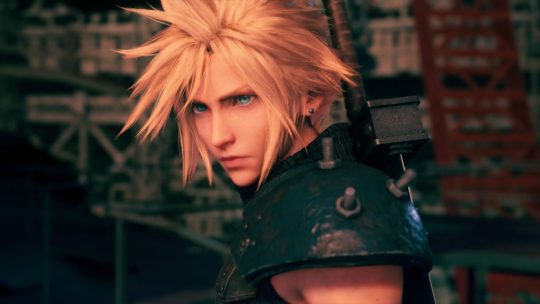
If you’re an FF7 fan reading this review, you’re probably here to find out how much of the game is present. Remake has been split into multiple parts after all, and this is just the first. Square Enix did this to cut as little as possible from the game, sparing no expense in remaking it to the fullest. Having now finished, I can say that they achieved that aim so far.
Content wise, there is a full game here, and my playtime ended at 43 hours. This entailed playing on Normal from start to finish along with being thorough and doing as much side content as I could. Further, additional perks and content become available once the credits roll. If you’re worried that you’re paying full price for an unfinished game, don’t; this is as much a full release as any newly numbered Final Fantasy title, and without Final Fantasy 15’s wealth of DLC required to make it whole.
“Pretty much every locale, scene, and story beat from the original is present in Remake.”
That said, Remake takes place entirely in Midgar, in contrast to the five to ten hours spent there in FF7. Pretty much every locale, scene, and story beat from the original is present in Remake. The additional time is primarily spent to bolster these moments, expanding on dungeons or smaller areas to give them the same scope. A tremendous amount of attention and care has been given to every facet, though. Character banter and dialogues are numerous, with a lot more cutscenes and chances for each to express themselves. Much of the runtime is used well, with new areas and events feeling interesting and consistent with Midgar’s style. Only a small fraction feels like genuine filler.
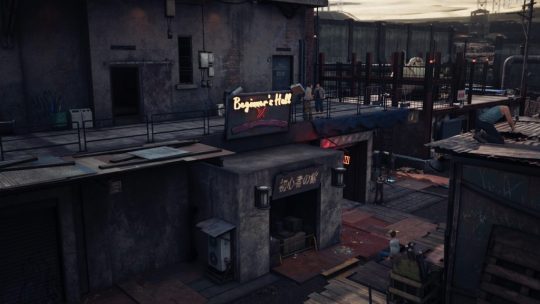
Final Fantasy 7 Remake is fairly linear at first. You’ll proceed through a chapter in a fairly direct fashion, with some side areas and branching paths to explore for treasure and extra fights. Once you move to the next chapter, you likely won’t be coming back. There’s a handful of areas where the game opens up, allowing you to explore a more populated area and take part in side quests and mini-games. One area relatively late in the game opens up quite a bit more, bridging a couple of areas together and allowing an open-ended respite before funneling you towards the final few chapters.
You’ll gain access to a chapter selection function once you beat the game, however. This lets you go back with an experience/AP gain increase and find anything you missed, as well as access the post-game content. I’ll come back to specifics later. So, how does it play?
Mechanics, Materia, and More
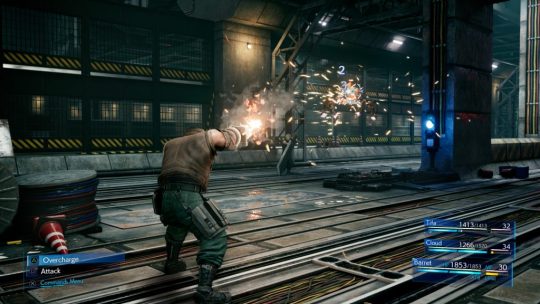
Final Fantasy 7 Remake continues the trend of Square Enix games becoming more cinematic and action-heavy in battles. If their aim is to make a playable Advent Children, they’re getting pretty close. This time around, the Active Time Battle (ATB) system of old has been merged into this for a pretty compelling take on an action/RPG.
You start the game as the main character Cloud. Combat will consist of utilizing his basic attacks, as well as manually guarding or dodging incoming damage. Your ATB gauge fills over time and increases when you strike, at which point you can open a menu to expend it. Time slows dramatically in the menu, letting you select from abilities, magic, and items. You can hold up to two bars of ATB (with the option of a third later), and every menu action requires at least one to use. These abilities and spells can be interrupted, but they hit considerably harder than your basic attacks. The damage difference is noticeable, so don’t come in expecting a pure action game; you’ll need the turn-based menu abilities to progress.
Once you get other party members, you can freely swap between them with a D-pad press. Characters you aren’t controlling will play defensive and try to get attacks in when safe. You’ll be the one ordering them to use menu abilities as they build ATB, though, and it becomes quite intuitive to cycle through them as you need.
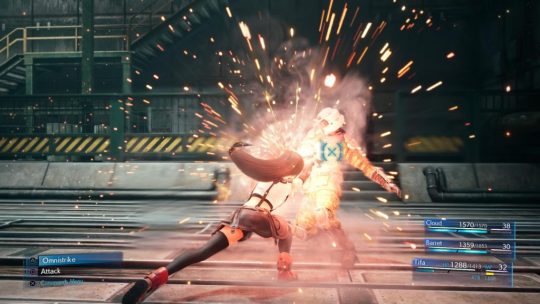
To keep things fresh, each party member has a set of different mechanics and playstyles. All have an attack string and guard/dodge options, but that’s where similarities end. The triangle button is dedicated to the character’s unique actions. Cloud swaps to a slow-moving, hard-hitting Punisher stance, Tifa has finisher attacks based on the stacks of an ability she has, and so on.
“Of the handful of hybrid action/RPG systems the series has tried, Final Fantasy 7 Remake definitely feels the most well-done.”
Charging time is pretty slow if you aren’t getting in the thick of it, but this also leaves you quite vulnerable to attack. Guarding is a trade-off, as it slows your passive ATB gain dramatically, so trying to stay aggressive and dodging smartly is encouraged. This is further compounded by each enemy having a break meter below their health; hit them enough or with certain attacks and you’ll pressure them, which usually stuns them and makes them take more break damage. Max it out, and you’ll stagger them, wherein they’re completely stunned and take a large increase to all incoming damage for a time.
Of the handful of hybrid action/RPG systems the series has tried, Final Fantasy 7 Remake definitely feels the most well-done. It avoids the spamming of items from Final Fantasy 15 and ends up feeling like a Final Fantasy 13 that you actually control.
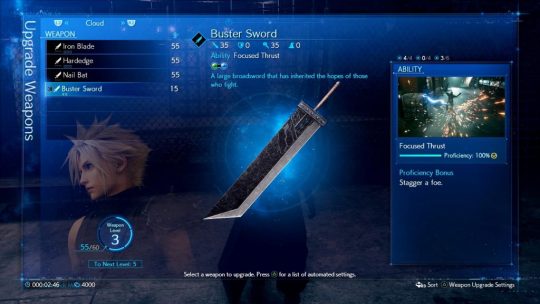
If this seems basic, there are further ways to supplement your moves. New abilities are gained in two ways: learned from specific weapons, or gained by equipping materia. Weapons are spaced out throughout the game, and each has a specific ability. Use that ability in battle a handful of times and you’ll achieve proficiency with it, whereupon you can use it regardless of your weapon.
Materia is the major noteworthy mechanic from FF7, and it’s been carried over almost identically to Remake. You’ll find materia orbs as you explore, and these can be set to slots in weapons or armor to gain their abilities. Furthermore, you’ll level the materia through AP gained after battles. A Fire materia will grant the Fire spell to the character while held, for example, and can be leveled up to access Fira and Firaga. Materia can be freely exchanged between characters out of battle, and most strategies for tougher fights will hinge on your setup. Different materia types can offer passive buffs, active abilities, or even massive summons that can be used only in specific fights.
At first, you won’t have much materia to play with, and even fewer slots in your gear to equip them. Cue Remake’s weapon upgrade system. Every time a character levels up, they’ll get 5 SP to spend, with bonus SP available from side objectives later. Each weapon has a unique “core” skill tree, and SP unlocks nodes on it. Each unlock grants the weapon new passive stats, modifiers, or even materia slots. At certain level thresholds, you’ll gain access to new sub-cores to further customize them.
What’s more, each individual weapon gets all your SP retroactively, so no need to pick and choose which to invest in. This means that if you like Cloud’s Buster Sword, you can absolutely keep it relevant throughout the entire game. All weapons have their own unique identity now, with stat priorities and abilities that you can prioritize based on circumstance or playstyle. The build options are quite diverse, and since you can reset them for a small gil fee, there’s no wrong way to approach it.
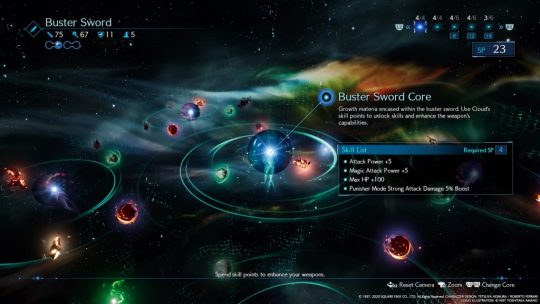
All these systems are in service of allowing you to customize your characters for the battles to come. Each ability has its uses, and there’s a good selection of materia to play around with. What I found most limiting about the battles, then, is the action parts.
Those who played the demo might have expressed some misgivings about the lack of variety in Cloud’s moveset. For those who feel that this is pretty basic, I’m sorry to say that it won’t get that much more diverse. Almost every ability and materia is one selected from the menu, not in your basic attacks. The different playable characters and conditions of encounters might shake things up, but it’s the ATB spenders that receive most of your attention.
I found this especially disappointing because my expectations were set quite high from the outset. Exploring down a side path in Chapter 2, mere minutes after where the demo ended, I found the Deadly Dodge materia; this changed Cloud’s attack string immediately after a dodge into a larger AoE one. Finding this so early eased my fears that the combat would feel similar for the whole runtime, then! Surely there would be other modifiers like it if I got this one so early?
Nope! This is almost the only materia like it in the whole game.
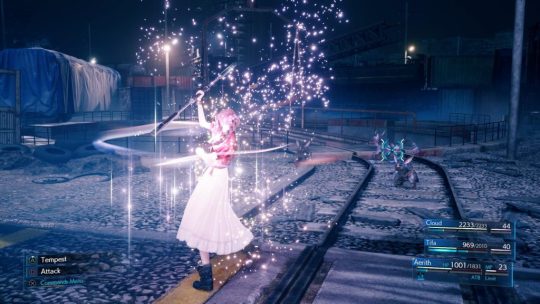
Much later, you can get the Parry materia (which lets you do a short hop and strike back if using dodge while guarding), and that’s about it. All other materia like it is simply a passive effect or occasional long cooldown. Otherwise, it’s all menu abilities that require ATB. This was tremendously disappointing to discover, and more options like that to personalize my general moveset would have been so much nicer to have. Even something like a perfect guard would have been great, though at least Cloud’s Punisher mode has counters on block. Perhaps that’s on me for coming to Final Fantasy 7 Remake having just played Devil May Cry 3, but that’s how I felt regardless.
That misgiving aside, the battles are nonetheless fun experiences. Bosses in particular tend to be larger than life affairs, with multiple parts to attack and various phases of the fight that change their mechanics. Again, those who played the demo will be pleased to note that more bosses play in the vein of Scorpion Sentinel than not. Some encounters can be pretty challenging, though for every game over I encountered (maybe half a dozen), a quick adjustment to my materia loadout and shift in strategy saw me triumph next time.
“There was a hell of a lot to love about the battles in Final Fantasy 7 Remake, and even if I had been hoping for more, it still stands out as a damn good time.”
Even regular enemies have individual mechanics. The circumstances by which the pressure and stagger systems are applied is unique to most enemies, so learning and exploiting their weaknesses makes the experience much smoother. There was a hell of a lot to love about the battles in Final Fantasy 7 Remake, and even if I had been hoping for more, it still stands out as a damn good time.
Mini-games are also interspersed throughout Final Fantasy 7 Remake. Most are variations of what was in the original, but there’s been a few added just to break up the routine. They were enjoyable for the most part, so there’s not much to say about them save that I appreciate the inclusion. There’s also a coliseum, letting you fight specialized groups under set conditions in exchange for unique rewards.
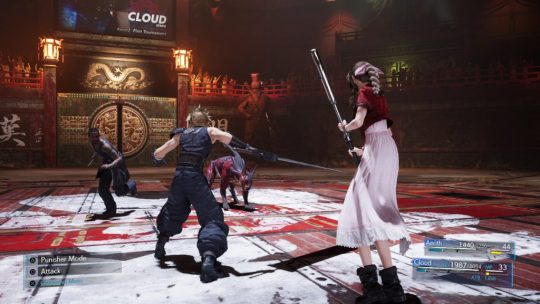
After the credits roll, you’ll gain access to the Chapter Select and can revisit any part of the game. You’ll also unlock Hard Mode, which doesn’t serve as a difficulty selection for a new game; instead, you can activate it when accessing Chapter Select. Hard Mode locks out your items and stops MP recovery from rest spots, but offers unique collectibles in exchange. New battles are added to the coliseum also. Those who want more even after the game is over shall find there’s at least a little to check out.
Overall, Final Fantasy 7 Remake kept my attention for the whole runtime. The only real lapses were a few areas of traversal that were overly drawn out, and some of the side quests felt a little mundane. Even so, these featured additional cutscenes and conversations with the cast that really furthered the attachment to the world, so it at least felt worth it to do them once finished.
Tifa fans should do all the side quests in Chapter 3. Just saying.
Regardless, it was an enjoyable game to play. A little more concession to action mechanics would be great, but the hybridised action/RPG implementation was otherwise very impressive. Square Enix definitely seems to have arrived at a happy medium that previous Final Fantasy titles didn’t manage, and I hope they continue with it.
Presenting: Midgar!
youtube
Presentation is the shining star of Final Fantasy 7 Remake. The demo made it clear that Square Enix wasn’t messing around, and it’s honestly one of the most graphically striking games I’ve ever seen. If any concerns were had about that level being impossible to maintain consistently, they certainly kept it close. Some of the larger open areas — particularly the slums — suffer from character pop-in, delayed loading on textures (if they aren’t just rough or muddy outright) and other small nitpicks. In addition, some cutscenes with minor NPCs talking to party members can be pretty jarring. They simply cannot match the level of fidelity achieved in rendering the main cast or other notable characters.
When the main cast is the focus and the set pieces are rolling, though? It’s far and away beyond anything else the series — or Square Enix in general — has produced. There’s a lot more daytime than the original game, so there’s enough colour variety to keep it from looking bland. Mechanical dieselpunk designs weave into gritty but “lived-in” slum streets. A pristine plate sector at night gives way to rusting maintenance structures underneath. The tall, clean and imposing Shinra HQ is met with the garish lights and noise of Wall Market. Midgar is a fantastically designed place and a treat to explore.
It’s not just the city itself that is well designed, though. To Square Enix’s credit, they have taken the sometimes goofy enemy designs from the original and kept them completely intact. High fidelity or no, it’s not afraid to take an enemy that is just a spiky dancing frog and have it make sense. There are even character dialogue and bestiary entries that further suggest how they work or came to be. If things didn’t have to be changed, they weren’t; they were just reimagined and made to fit.
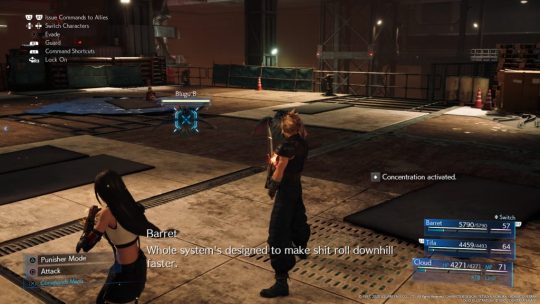
“Midgar is a fantastically designed place and a treat to explore.”
All of this visual and design splendour is furthered by the audio quality. From start to finish, the voice acting and direction is stellar. Shelving the voice actors that played the characters previously was unexpected, but the new cast absolutely nails their roles. Most have emotional moments or serious scenes that the actors manage to capture effortlessly. Even the NPCs and minor characters have quality voice acting. Shoutouts, in particular, have to be given to Barret’s VA for one particularly memorable scene, and to Hojo who is suitably creepy and sinister in every appearance.
Last but not least on the presentation front: the music. Oh man, the music. NieR: Automata laid the groundwork for implementing dynamic tracks, adding layers as needed to change the tone of the same track at just the right moment. Everything that was learned from that game was applied wholeheartedly to Final Fantasy 7 Remake, and then some. Musical cues and stings are on point, highlighting crucial moments in the best possible way.
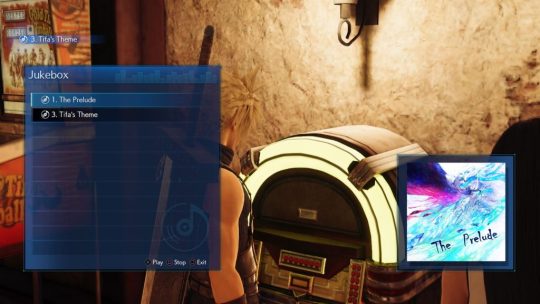
The original soundtrack is regarded as one of the finest works of legendary composer Nobuo Uematsu. Now, most of those tracks have been remixed or remastered in a slew of creative ways, but they almost always fit the tone required well. Some see multiple variations in different areas to wholly distinct effects. Music in the boss fights tends to really stand out, as the longer battles allow them to build up and crescendo during later phases. You know that the music is a highlight when songs are one of the main collectibles and each is a separate remix from their actual game appearance, all done in the style of music that might actually be made in Midgar’s setting. Genius.
There’s quite a lot to unpack and respect about the game on presentation. But all that presentation is in service of one thing: telling the story.
Reunions
I fully intend to avoid spoilers, so I will keep this section relatively brief.
The story of the original Final Fantasy 7 is one of the major elements that left a mark in gaming. These characters, their world, and their tales are iconic and beloved. Every moment of that story has been retained in full, just as Square Enix originally intended. Some trailers have hinted at adjustments and new developments — especially the launch trailer, which I encourage you not to watch for fear of spoilers — but this accuracy was paramount to the developers.
It’s safe to say that they achieved this. Every notable character, conversation, or location from the original game is included in Remake in some way. There’ll be adjustments, of course; they’re displayed in high fidelity and voice acted this time, so concessions will need to be made. But it’s all here, and the attention to detail in places was honestly staggering.
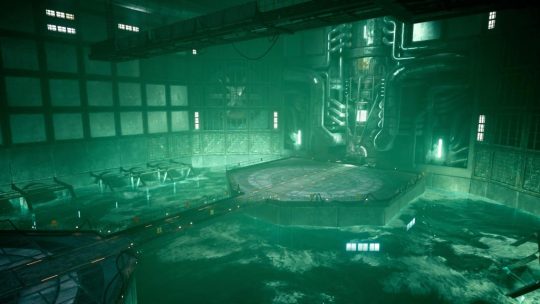
With that said, Square Enix had no intention of just retelling the same story verbatim. Additional scenes and moments have been sprinkled all throughout, with at least one early chapter composed entirely of new events. All of it builds on the original framework, strengthening it further. There’s more character growth, banter, and interactions between the cast than ever before. It ends up making them feel so much more real and believable. Even characters I wasn’t certain about initially won me over by the credits. This isn’t limited to the cast either, and gives the same treatment to villains and NPCs.
The fact that this is only a chunk of the complete tale means that certain events, characters, and flashbacks have been brought forward in the timeline. You’ll be seeing Cloud get headaches or recall memories of his hometown right out the gate… and that’s to say nothing of Sephiroth. Even so, all of these concessions are handled with the same care as the rest of the game, so their placement fits and strengthens the whole. Better to portray these scenes and build up the characters now than have them appear out of nowhere 10 hours into a second game, right?
Now… thus far, I’ve been talking purely about parts that primarily concern the original work. If this praise was also true of the wholly original plot threads and changes, I’d have no issues whatsoever with Remake’s story. Unfortunately, that isn’t the case. Far from it.
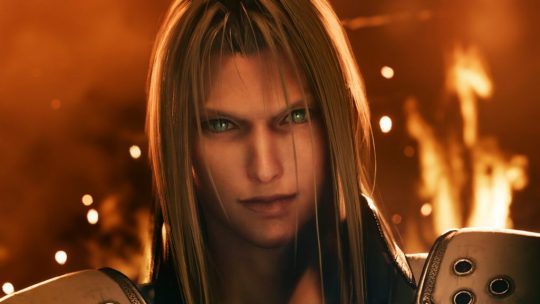
Early on, there will be a couple of divergences to the story that seem to be setting up a new sub-plot. These divergences increase in volume over time, and grow exponentially in the last two chapters. All the original beats remain, but they’re interspersed with these divergences, leading to a new climax and expanded conclusion.
“Genuinely, I was loving my time with it. But if the game had been a tasty meal up until that point, the final section soured it.”
And here is where it all started to come apart for me. For a brief while, I was ripped out of Final Fantasy 7 and dumped heavily into an unholy marriage of Advent Children and Kingdom Hearts. It was awkward, it was confusing, and it left me shaking my head in dismay. It felt massively out of place.
Did this part have to change so dramatically? Maybe. It wasn’t a true climax or game-ending point in the original, after all, and I expected some new conclusion and an added boss or two to cap off this experience. Yet, until now, it had been such a solid remake that made measured changes to supplement the classic story. Here, at the eleventh hour, it jarringly erupted into a massive spectacle that honestly felt like underdeveloped fanfiction.
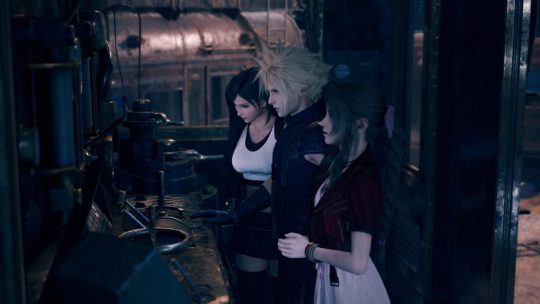
When I say spectacle, I mean that it was spectacular to behold in terms of graphics, sound, scale… but it comes at a huge cost, and that cost is the integrity of the story going forward. This finale and the accompanying changes have massive implications for the future installments of Remake, all of which feel like they’re going to ride the divergence train at full speed away from the classic plot. Suddenly, the insane turns that things like Dirge of Cerberus took are looking far more likely in the future.
I had been enjoying Final Fantasy 7 Remake throughout the entire runtime, whether it was new or old material. Genuinely, I was loving my time with it. But if the game had been a tasty meal up until that point, the final section soured it. This isn’t just because they tried something new, either; I could easily forgive it if it was just a new thread that tried, landed flat, and wrapped up. No, this sudden divergence has ramifications that could potentially change all future installments in dramatic ways from what was expected, and I now find myself lacking confidence that it can succeed.
In conclusion: old stuff? Great! Supplementary additions to old stuff? Also great! Character writing, development, and worldbuilding? Excellent! Brand new stuff? Middling at best, potentially disastrous at worst. Most of my grievances with the game are almost entirely to do with that final section. I fully admit to bias in the kinds of stories and developments I like, so your mileage may vary. But I cannot say I walked away from the ending feeling happy.
A Final Fantasy For Fans and First-Timers
One of the big questions approaching this game is, inevitably, “Should I play this if I haven’t played the original?” That’s an easy answer: yes. Everything is here that made Final Fantasy 7 such a stand out of its era, delivered with some of the finest presentation we’ve seen in triple-A video game development. It’s a fun action/RPG hybrid with solid gameplay systems, a strong story, and a set of well-realized characters that suitably develop and bond over time. Fans of the original will inevitably spot more references or appreciate the extra nods, but even newcomers should be able to slip in and find plenty to enjoy.

Next: should you play this now, before the other parts come out? That’s a more tentative response, but yes. Had I not walked away from the ending with such mixed feelings, it would’ve been easy to recommend. Even without knowledge of the source material, the main story and throughline here is clear to follow and wraps up nicely. It’s mostly the setup of larger threads and what’s to come that have me so hesitant to recommend it, and I don’t think the ending was handled well. Buyer be warned, regardless.
“Final Fantasy 7 Remake is arguably the best non-MMO Final Fantasy game released in a very long time.”
Final Fantasy 7 Remake doesn’t replace the original. That’ll be true even when all parts have been fully released. Final Fantasy 7 will be a generational touchstone of gaming with a legacy that has lasted decades, and will remain long after the hype for Remake has cooled. I don’t foresee that same legacy being granted to Remake once the dust has settled, but it nonetheless stands with Resident Evil 2 Remake as a testament to the quality such a project can aspire to.
This is still one of the most excellently presented games I’ve ever experienced, and with a few tweaks for the next installment, that excellence might extend to gameplay and story too. Whatever misgivings I may have going into future releases, it’s undeniable that this was an enjoyable 42 hours marred by a single bad one. Even so, Final Fantasy 7 Remake is arguably the best non-MMO Final Fantasy game released in a very long time. Despite my qualms, it’s been a welcome Reunion.
April 6, 2020 6:00 AM EST
from EnterGamingXP https://entergamingxp.com/2020/04/final-fantasy-7-remake-review-for-the-reunion/?utm_source=rss&utm_medium=rss&utm_campaign=final-fantasy-7-remake-review-for-the-reunion
0 notes
Text
Star Wars: Battlefront 2 - Release
There's an Ideal way to play Star Wars Battlefront 2's 40-player Galactic Assault mode. I haven't mastered it, but it is about maximizing the point value of every life and spending these points in the perfect way at the ideal time. "Man, I want more things to unlock Yoda" is something someone could say on TV to signify they're a gamer. I have said that multiple times. I am a mockery. However, I do enjoy it. I do need those points. If the effort's narrative were improved and the development system not so irritating, I might have liked Battlefront 2.
I am Mostly speaking about Battle Points, which are earned and spent mid-match to spawn as X-wings, AT-STs, leap troopers, Wookiees, and all sorts of other Star Wars combatants, including heroes and villains such as Yoda, Rey, and Kylo Ren. Your primary goal in any multiplayer mode isn't your team's objective, whether that is blowing up a giant transportation tank at Theed or stealing an AT-AT on Endor. It is earning those things so you can do some real harm.

When I have too few things to spawn as anything trendy, the race Playing as a regular trooper feels like being an extra in the movies, as you're likely to get smushed by walkers and also have your courage cauterized by lightsabers close to the conclusion of a match. It's fun to be a part of the spectacle, but the next time Darth Maul murders you that the pleasure wears off. Conversely, once I have spent things to spawn as a particular droid or a man on a speeder bike or Rey herself, my entire life becomes precious, and I become attentive--personalities are dominant, but not unkillable.
Every small Killstreak: more points! Every goal play: more things! I'm excited, sometimes frustrated, as I work to make a strong character, and then I get there, and I feel like a god who only found out he is mortal and so is extremely pissed off about it--scared to perish, but eager to crush stuff.Most of my time is invested as a regular trooper, however, and the primary shooting is more enjoyable in the effort, where the attention is all on spectacle (since it certainly wasn't about the narrative). There, many enemies are weak enough to kill in 1 headshot, while in multiplayer shields can take a beating, so making most kills feel nostalgic: my shot occurred to connect with someone whose shields were already at 20 percent. Along with the map layout, though beautiful, can result in some dull struggles. In the confined spaces most maps finally push both groups into-- room to defend, like the Mos Eisley Cantina--it's a lot of reckless charges and grenade spamming, or piling up on walls and playing peek-a-boo.
Every class has three special abilities, which Change in utility and fun. The Officer course can drop an auto-turret, but it is a puny small machine which makes very little difference--it feels pointless. The whistling sound impact loop that plays while it is equipped is sound adrenaline, and its lethality makes it much more entertaining than the stock blasters.

The most peculiar thing about the Battle Points mill is its impact on teamwork. Building a cautious approach as a squad isn't a reasonable thing to do in Battlefront like it is in the Rising Storm and Battlefield series. It is a race for points, and also in a race that you operate, usually directly in the objective (a jog that takes too long on many Galactic Assault maps) to lob a grenade and attempt to score some frantic kills before dying. From the Starfighter Assault area dogfighting manner, I find that players also tend to focus on player eliminations before objectives, which include fleets of AI controlled ships to assault and mines to ruin.
DICE creates an Effort to fix this: when you respawn, you are automatically placed into a squad, and playing near your squadmates makes you double Battle Points. But usually, my squadmates break off and do their things anyhow, or perish too quickly to help. They're hungry for those points, but it is a personal pursuit. I'm annoyed when someone catches an Ion Cannon before I could to burst the MTT on Theed because playing the goal earns points, and these points should've been mine. It doesn't make for cohesive groups.
Unlocking Luke
You will find even more points, known as Credits, a non-cash currency you Earn by playing matches and attaining milestones--the better you represent, the more Credits you receive.
Star Cards are a Largely dull method to produce your classes, ships, ground vehicles, and heroes more powerful (I'll refer to all these things as 'classes' from here on to make it simpler). They're like Call of Duty's perks, except you can equip three in a time each class so long as you have sufficiently leveled up that category, and lots of them are direct buffs. More wellness. Abilities recharge quicker. Increased primary weapon harm.
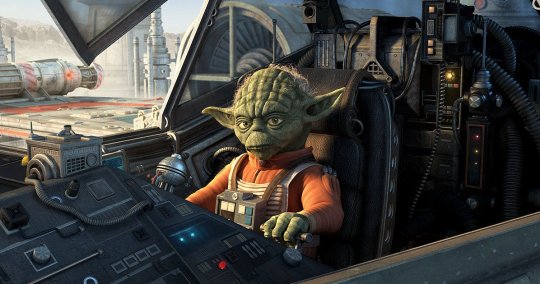
I Do not enjoy it, and I doubt I will no matter how much EA tweaks that the speed I get Credits or the expense of unlocking heroes such as Luke Skywalker. I don't want to quit matches to visit the 'career' page to gradually redeem Credits for each small milestone. I don't want to fight somebody whose TIE-fighter is numerically more potent than my ship.
A number of the Star Cards are trade-offs--exchange your sanity for a missile That locks on to vehicles, for example--and I don't have an issue with those. I also don't mind that new firearms and attachments require earning kills with a class, although it sure takes a long time. But I don't wish to poke through a hundred menu displays (not an exaggeration) equipping little upgrades which make my weapons cooldown quicker, and I do not wish to fight a participant who has.
It is a system that instills doubt, and They probably did, but how do I know their updated Star Cards weren't the difference maker? Did I mention you can update them? Sometimes you'll get Crafting Parts in loot boxes that can be used to make specific Star Cards you need, and upgrade current ones to make them stronger. It's too much.
When the premium currency was still accessible (microtransactions were temporarily eliminated On November 16), I did not feel much pressure to buy anything, because I earned those orbits I don't want at a good enough pace (I could unlock Luke when I need) and, frankly, I probably wasn't really becoming crushed because I'd like fewer Star Cards than more-skilled competitions. However, my difficulty isn't only that gamers could purchase electricity, though that's frustrating. It is that, to facilitate micro-transactions, development is slow, over-complicated, and unfun. I am skeptical that it will get more interesting and less problematic before the premium currency comes back unless it is overhauled and the returning micro-transactions use only for makeup.
The Effort
Outside of multiplayer and all that progression nonsense, the Four-to-five hour campaign is a pretty good time. The story is bland but well-acted and there are some amusing lines and entertaining cameos.
You primarily play as There is one special smash cut meant to demonstrate that Versio made a moral decision which I thought was a bug at first, because of how little persuasive she needed. It feels like a comic book that was drawn before it had been composed. Every other page includes an exquisitely-inked conflict we have to reach, so in between a few speech bubbles are full of to explain why our personalities are involved in it.
After a few missions, the characters all do precisely what they say They are going to do, and all agree with each other all the time. Their significant choices are made whimsically, and they mostly grow off-screen as we leap between the galaxy's famed battles. The dialogue itself can be amusing and smart, but the larger story is inconsistent as if large chunks were cut--except in one specific mission that slows down things.
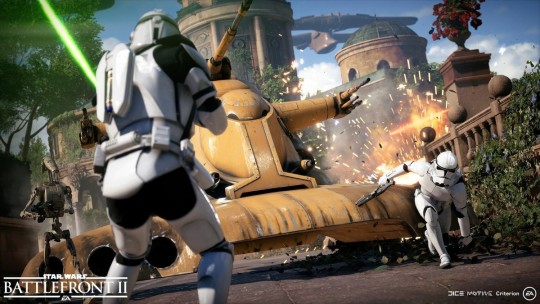
Utilizing The Force using a lightsaber is suitably simple, and I awakened how it made me worry more about defeating a military with style than perishing. As a fanatic of this galaxy, it wouldn't make sense for a Stormtrooper to even scratch me, and there is a fun game to trying to create my playthrough canon, mixing up cool skills the way I think the character would. Holding down the perfect mouse button to auto-parry the same blaster fire I'd been hiding from in the preceding mission feels badass.
In assignments without space magical, However, Battlefront 2 is not too hard. In the singleplayer and multiplayer, the speedy fighter ships are trying to maneuver but get close enough, and my primary weapon will soft-lock on an enemy--so that I feel skilled at dogfighting. However, I'm not likely to do it with no targeting computer.
On the floor, I'm neither pinned to cover nor allowed to run around where I want. Just a couple of enemy types are spongy, and the remainder often goes flying through the air using a single grenade or headshot, which makes for proper-looking Star Wars battles. It strikes a pleasure balance between fragility and power, letting me perform with enough bravado to experiment, but not too much that I do not need to eye my shield meter and retreat to cover when sprinkled.
The major annoyance is that the checkpointed saves, particularly in the distance. Slightly too slow at destroying all the bombers because you moved off to explore before the prompt showed up? Do the entire segment over. Did a great job with the bombers but accidentally trimmed some debris? Start over. And as there's no ammo to discover on the ground--firearms generate heat which must be dissipated--there's disappointingly little to research the main route. In the first assignment's light stealth section, for example, corridors I was not supposed to return only led to closed doors.
I've encountered a few bugs, as well. The most Egregious was when I defended my grounded boat from endless waves of Enemies for many minutes--I wasn't counting--before realizing something Must be erroneous. A ramp was designed to fall a couple of moments in so that I could escape. At Least it occurred on the next attempt.
1 note
·
View note
Text
Musings: What I hate about D&D 5e
I have been playing 5e continuously since it came out, up to three times a week, both as DM and as player. While I enjoyed my time I also have recently mused about its limitations, especially in the light of books I have read, so let me share a bit of that...
A typical D&Dism I observe is this: I roleplay/play-act a character. I try to make him shady, evasive, just shifty in general. Then, after having done all of that, one player asks “Can I roll Insight?” I could have saved myself all the trouble, really.
You see, actual play-acting is for the benefit of the player, not the character. It immerses the player in the world, it draws him to interact with the GM as interface, it gives the NPC a face, mannerisms. If you ask for a roll after that, you - in my opinion - completely negate the information you got (except maybe: “something’s shifty here, let’s double check”). Is this good roleplaying? I say no. Is this realistic? Research says even experienced investigators and detectives cannot simply tell an experienced liar. (Hell, not even lie detectors can!) Not even if they roll 20s...
But the idea is pervasive. I get to roll and I get the info. Frankly, from my point of view I come to the conclusion that the whole conversation could be shortened to this: “The guy tells you he’s offering you the goods you are looking for.” - “I roll insight.” - “He seems shifty and untrustworthy. You wouldn’t trust him.” See? From a “character skill, not player skill” perspective this is okay, but I find it the least engaging way to roleplay. It’s roll-play. You don’t have to engage with this NPC in any meaningful way. You just roll dice. I say this is some sort of lame game about dice-rolling, but it is no longer an interesting experience of roleplaying. I frankly hate it.
This typical of D&D. “Detect Alignment” may be gone, but the game still has essentially a “Sense Motive” roll to help you avoiding using your actual brain, emotional intelligence, or people skills. It teaches nothing. It conveys nothing. The only thing it leaves you is to make some kind of decision.
A recent article I read made the point that players prefer to be puppets, being led along the strings of rather railroady modules. And from my experience, many players flounder when actually having to rely on their own judgment and having to make their own decisions. The game does not require, even less teach critical thinking any more. It just offers a premade experience you slot yourself into.
And what kind of experience is it? It is essentially an experience of killing premade monsters in typical plots. What is an adventure module? A series of encounters engaging you in the combat mini-game with some other bits thrown in. The skill required from the GM, if he even bothers write his or her own material, is to squeeze the right amount of monsters into an area to provide challenge. This number is usually predetermined by formulas. The skill required from the players is to use resources efficiently to make it through the preallocated number of encounters to win the day or adventure altogether.
In other words, the skills required in playing D&D is mastering the combat mini-game. Recognize (or memorize) the weaknesses of your opponents. Devise tactics and apply them. Rinse and repeat. Many have argued that you don’t need to use tactics much. I think it was the AngryGM who argued that maximizing damage output wins pretty much every combat. Great. In other words: It is not a good tactics game either. Offense wins.
The reality of D&D is that it is a game about killing things. It is a fantasy game in the sense that your opponents are fantasy creatures, but the way the rules keep on evolving engaging with a fantastic world is absolutely optional. Some people would argue you can play D&D without combat. You could have a D&D game entirely based on interacting with people. And that is true, but that is not what the game is made for or optimized for. Almost all spells are optimized for having effects in the combat mini-game. Interestingly D&D computer games disallowed casting most spells outside combat. If you factor in every spell’s combat applications with all other combat-related rules, you will find that the PHB’s rules consisted predominantly of combat rules. Spells are mini rule systems geared mostly towards combat.
So, a D&D adventure can be seen as a frame to explain why combat happens. It sweetens the combat experience by giving it narrative sense. It uses combat as challenge and key junction in the adventure. Other elements of play are considerably less important to average play and can often be skipped over by applying the right skill (roll) or casting the right spell. D&D, especially 4e, has often been criticized to being like a cMMORPG, and frankly, rightfully so.
Because D&D is extreme in its emphasis on combat.
What tools are given to the GM? He gets a whole book of monsters for keeping his players busy. He gets 70 pages or something full of magic items to keep players happy and enhance their combat abilities. He gets rules for making combat encounters, for varying them, for gauging their challenge, and for arranging them into in-game days. D&D is convenience. I have to say, D&D does a lot to actually make it convenient to run it. It is not hard to have the run-of-the-mill D&D experience. It is formulaic. With a slightly better encounter-building system (from Unearthed Arcana) it minimizes prep even further.
D&D is a game about meeting creatures and killing them. This is one of the major ways of earning XP, the game’s main reward. The thing is so engrained in D&D so hard that it often is hard to get players to respond in any other way to challenges than to murder hobo the shit out of them.
Some may say this just reflects my lack of skill as a GM. And frankly, I would counter that is fanboyish lack of critical thinking. How do you like them apples? Seriously. Defenders of D&D have always trotted out this lame argument that you can do anything with it. Good grief, game design is about what you reward in a game, and with D&D it has always been either looting or killing, and by now it also gives a nod to reaching story goals. You can put it on yourself to run a game where you reward things other than killing and check-marking plot points, but frankly, you have little support there. You could modify the XP values to discourage killing as the main driver of the game. But then you have to realize that you are engaging in redesigning the game’s reward system and focus. Its rewards (XP and magic items) are geared predominantly towards getting better at killing things and collecting loot. If you want to change that, you have to ignore a large part of the game or redesign it.
Compare this: Savage Worlds or even d20 variant Numenera don’t give XP on combat. In other words, combat is not an inherently attractive way of resolving conflict. It is risky, it costs you resources, and gains are unclear. This is just one example of shifting focus away from combat encounters. I’m not saying that Savage Worlds or Numenera are in any way pacifistic games. They do have, in fact, quite sophisticated combat systems, and Savage Worlds actually is geared towards being played on a grid. I’m just saying, D&D is extreme in this regard. 4e is infamous for being a hybrid between a miniature tabletop combat game and some added role-/roll-playing. 5e is not inherently better but simplified the combat mini-game again.
I personally would hope that the game engages players, encourages critical thinking, and plays without much discussion about the rules. I have found it does the opposite. Even long-time players constantly look up spell definitions. Every session has discussion about how class powers or spells work. And engagement is minimized by asking for rolls or other intellectually lazy pursuits. Frankly, I have noted that my players cop out more often even from the inherent problem-solving and try to arm-wrestle me for advantages. They argue basic declarations like how dark it is, lawyer the rules, criticize me when I do rules-as-written but also when I do rules-as-intended, and generally tend to ruin my own enjoyment of the game. And frankly, D&D is part of why. First it taught them that all challenges can be overcome with a modicum of effort and rather little creativity, then it taught them to rely on rolls, then finally some even refuse to engage with the game altogether - they simply start to argue with the reality around them that they should have an easier deal.
Imagine you would engage with life like it. First all your challenges at your work or your significant relationships would be spoonfed to you. You get used to it and crybaby about its unfairness if that ever changes. And finally you argue with God or the laws of physics or whatever to actually get a better deal out of life because you can’t be bothered to work, eat, or breathe on your own. Welcome to the Universe of modern D&D where the DM doesn’t have to bother to come up with much anything and where the players don’t have to bother with thinking about the game or engage with it. Welcome to the game that dumbs you down relentlessly because dumb players can be sold more premade products. Making premade products in turn gets easier because players expectations are low and players embrace and expect the formulaic experience and brand anything deviating from it as “not D&D.” “Designers” and authors then cater to the formula, apply it with some skill, and people pay them money.
Welcome to dumb consumer D&D. It has not been born 2017 or 2015, but it sure has reached new heights. The Wizards of the Coast do not even bother to give us new settings. They don’t bother to give us settings at all. Why give you something you can make your own adventures with? Here’s our premade adventures! Enjoy! Buy!!
The disempowerment continues. With AD&D/1e GMs were told that these are the definitive rules, this is D&D. Don’t bother making your own. The spirit let out of the bottle with the underdefined OD&D/0e was driven out. Gygax gives you the definitive game. Then premade settings so you don’t come up with new stuff. A Monster Manual or two to make sure you don’t have to make monsters. Now they no longer give you settings. You can roll everything. Have fun. Send us money. Let the hobby sink into irrelevance.
(Yes, I’m bitter. So what?)
3 notes
·
View notes
Text
Zul’s Top 9 Games of 2018
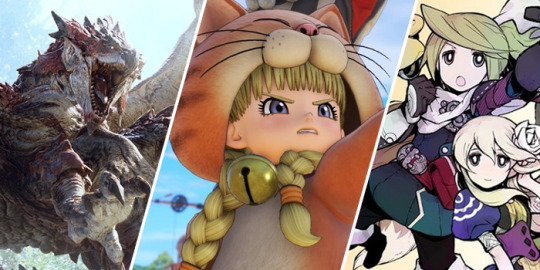
By Zul Edwards
Heyyy it’s me. I’m back! What a year! 2018 has come and gone and many awesome games have been played by everyone here at PAR. The votes were tallied, the results are in, and I am included in that bunch. However, some of the games I played and loved this year were no-shows on our list. Some AMAZING games that I think deserve a little love on our corner on the internet. So, I thought, if you out there reading this were interested, (spoiler alert, nobody is) here is my OWN personal top nine games of 2018.
So, let’s get this thing started with my number 9!... oh yeah, I only played 9 games in 2018. heh.
9) No Man’s Sky – So I was one of those gamers who was excited for NMS when it was first announced a few years back. Thought the idea of exploring a quintillion planet was awesome. Then the game came out, I heard it sucked, and I ignored it. Enter a couple years later when it was on sale, had a ton of updates and new features: true online with friends, customizable characters, base building, and a brand-new story. However, it wasn’t enough to keep me hooked. Don’t get me wrong, I liked exploring the various galaxies and doing various side quests, engaging in dogfights with pirates and mining for space gold, but overall it just still felt so empty, so repetitious, and so… blah. I guess I still prefer quality over quantity, even if the quantity is in the quintillions.
8) The Alliance Alive – The first on the list of “Games only Zul played this year”. The Alliance Alive is a 3DS game from the creators of the classic “Legend of Legacy”, literally a game I borrowed from Justin, played for all of 30 minutes, then promptly returned to Justin never to be spoken of again. So, to my surprise when he told me the same studio was making another game, The Alliance Alive, but it was helmed by one of the writers of the Suikoden franchise, I was cautiously optimistic. Much to my (pleasant) surprise, the game was good! A blend of classic JRPG turned based battles with flairs of modernization: skills learned through fighting, increased stats based on the location of fighters in battles, and a darker story not usually found in those classic SNES/PS1 RPGs this seems to emulate. While the main characters fall into some pretty cliché tropes, the side characters really shine. From giant axe-wielding lizard men that remind me of my own D&D character, to a demon-dog-man butler, to a mad child genius scientist who rides a duck robot, this game has a lot of flavor. I really should go back and finish.
7) Chasm – While it’s no secret that I love Castlevania games, I think it’s fair to say I’m not really a giant fan of Metroidvania games. I prefer the simpler side-scrolling action of Castlevania, constantly moving forward towards a goal of smacking Drac in the face with a metal whip, to the backtracking and map completing chore of most Metroidvania games. With that said, something about the less intense and simpler format of Chasm kept me hooked till the end. I didn’t mind backtracking and completing the map in Chasm because it wasn’t as vast or complicated as other games in the genre. It was colorful, had great music, stellar pixel art and a fun yet challenging battle system and platforming. Overall it was a blast to play, but it just got overshadowed in a year filled with superior games.
6) God of War – “WHAT THE FUCK?” I hear you slam on your keyboards as I place the unrivaled GOTY in a paltry 6th place. Don’t get me wrong, this game is good. In fact, it’s VERY good. However, for whatever reason, I guess this game didn’t hook me like it did for everyone else. I only have a passing familiarity with the GoW series. Even though I’m a diehard SonyBoy, I only ever played GoW 1 and never beat it. Kratos and Atreus are some of the best written and best-acted characters to come out of a video game in this year or any year. Hell, if we had a “best new character” category again this year, I would struggle to not put Atreus in the top 3. The music is amazing, the writing is fantastic, the scope, cinematography and the constant one camera perspective were all stellar achievements in the medium of gaming, not to mention I’m pretty much obsessed with all things Norse… BUT. I dunno. Little things kept taking me out of it. Atreus’s sudden, jarring mood swings. The poor pacing in certain parts. The sudden introduction of major characters and/or story elements, that felt kind of brushed over and/or rushed. The lackluster side content, the padding and the empty worlds. The game is good. But it never felt great to me. Most games that I love, I think about when I’m not playing them, then I rush home from work to play them because I want to complete them, either for the story or because the gameplay is addicting, but this game felt more like a chore sometimes. I didn’t even buy it, I just borrowed it from Butch earlier in the year when it came out. I’m sorry Cory. I tried but I just didn’t love this game.
5) Moonlighter – Now here’s a game I absolutely adored. Flew under my radar and was recommended by Nick. By day you’re a humble shopkeeper, selling various wares and curios. By night, (by… MOONLIGHT) you explore dungeons ala Link to the Past style in a top-down view, into randomly generated maps. Each area has different items to collect & new materials to find, which you bring back to the shop to sell, which with the money you earn, can craft new weapons, which will get you further into dungeons, which will mean you find more items to sell which means you make more gold to spend on armor and weapons, which means you can get better materials to keep delving deeper, WHICH MEANS… ahem. Ah yes. That classic feedback loop. It sucked me in. It’s simple but effective in keeping me engaged. Coupled with a great art style, fluid beautiful pixel graphics and a surprisingly good amount of story for this type of game, Moonlighter took a nice chunk of my time early in the year.
4) Ni No Kuni II: Revenant Kingdom – Another entry in “Games only Zul played this year”, NNK2 was a surprise hit for me. I never played NNK1 and heard rather negative things about it from Nick over the years. I bought NNK2 on a whim months after it came out because it was on sale and I was craving a good JRPG, and it did not disappoint. I loved pretty much everything about this game. The music, the story, the beautiful not quite Ghibli, but practically Ghibli art style, the characters, the mechanics, the town building, the combat… it was everything I was looking for. There were certainly parts in the middle that lagged a bit, and the general “go to town > solve town’s problem > make an alliance with the town” could be considered cliché or predictable, but every town felt unique and its inhabitants all felt genuine. Recruiting citizens into your kingdom and assigning them all a role in your castle was a time sink I didn’t realize I would be so into, but I think I spent more hours on that than anything else in the game. And it also gets marks for being the other child in a video game besides Atreus, King Evan, that I didn’t want to strangle, and in fact by the time the credits rolled, he’d probably be #2 or 3 in Best Character of the Year for me.
3) Dragon Quest XI: Echoes of an Elusive Age – Now as far as JRPGS go, Dragon Quest is the ultimate grand-daddy, even more so than Final Fantasy, but it was a series I never really got into. I played some previous games in the series and found passing enjoyment in a couple titles but never enough to ever want to complete a game or seek out other entries in the series. That all kind of changed when I played DQ 11. DQ has never really strayed too far from its classic turn-based JRPG roots. “If it ain’t broke, don’t fix it” would be their mantra I assume, and I love it. In a time when the turn-based system is all but gone from genre giant Final Fantasy, DQ has instead chosen to stick with it, and fully master the dying style. It was hands down the best JRPG I’ve played all year, and probably one of the best I’ve played in several years. It has everything: a great story, compelling characters, awesome music, amazing art style, engaging combat, fun side quests, a challenging yet fair difficulty curve, and it’s actually, really funny on top of all that. While the length might scare people away, (I clocked in right around 120 hours after getting the platinum trophy for 100% completion of the game) it’s some of the best time I spent gaming in a long time. It’s a classic in a modern era. It’s weird, if you said to teenage Zul “one of your favorite JRPGs ever will be Dragon Quest 11, and one of your least favorite JRPGs will be Final Fantasy 15”, he would never have believed you… but here we are.
2) Monster Hunter World – Ah yes. The one oddball in my gaming repertoire. I think we all have one of these, right? That one game/series that for whatever reason, sits outside your normal gaming habits, yet you love it, nonetheless. Maybe you love Halo and FPS games, but you also really like Animal Crossing for some reason. Or maybe you’re a diehard Dark Souls series fan but just can’t get enough of Cooking Mama as well. Variety is the spice of life they say, and while I’m primarily a “character & story first, RPGs, video games are art” kind of dude, something about smashing Monsters in the face with a giant hammer has kept me hooked on the Monster Hunter series for nearly 10 years. I love the challenging but fair battles, the deep customization, the various weapons and armors for both male and female hunters, the varied and unique monsters that all have their own ecology, musical themes, and battle styles you must learn and adapt to if you want to survive. It’s also linking up with friends (or even strangers online) and tackling a beast as a team. For all these reasons and so much more, this series sunk its claws in me from the very first time I played it, and it hasn’t let go. Monster Hunter World is the next-gen, beautifully realized game I’ve wanted for years; and it took the story, art, gameplay, and fun I’ve come to expect from this series to another level.
1) Red Dead Redemption II – I honestly don’t know how to write about this game. I can say all the other things I’ve said up until now about how great the music is (it’s amazing), how varied and alive the characters feel (they’re amazing), how stunningly awe-inspiring the scenery is or how fluid and lifelike the character animations are (they’re amazing), how the story and personal journey of Arthur Morgan literally brought me to tears more than once (he’s #1 in Best Characters btw. And they’re amazing), how rich every side quest is, how fun the mini-games are, how great the dialogue is, or any of the other truly breath-taking aspects of the game, but I don’t think I could do them justice. Hell, I don’t even know how to put them into words myself inside my own head. To me, this is one of those games that surpasses all of that. Yea, it has flaws, every game does, everyTHING does, but to me, it’s perfect, warts and all. I can’t give it much higher praise than that, and it is absolutely the best game I played in years. When a game can give me an extensional crisis during some of its final moments, I think it’s safe to say that It’ll stick with me and has undoubtedly set a very high bar for all future games. The team at Rockstar outdid themselves and have my thanks for bringing this game into the world.
PHEW. Well, that’s it. Top 9 games of 2018 according to Zully Boy. Another great year in gaming for me personally and here’s to another great year in 2019! Lots to look forward to, and hopefully some hidden gems that’ll surprise me along the way. Happy Gaming everyone!
0 notes
Text
Mortal Kombat 11 – Review
Mortal Kombat is more than a game: it is the closest thing we as gamers have to a counter-culture. It is an I.P. that has consistently laughed in the face of censorship boards by never compromising on giving fans the unfiltered carnage of close combat. This was literally (part of) the reason why there exists an ESRB rating system today.
What’s more, this violence is not just for looks – it is also about skill. The genius of Mortal Kombat’s formula has always lain in demonstrating the player’s fighting ability through how sadistically they can crush their opponent. You don’t just K.O. an opponent in this game; you FINISH THEM!!!
Is it weird to admire the way blood is animated in a game?
I am quite pleased to say that this 27-year-old spirit of Mortal Kombat is alive and well within the eleventh arrival. Let’s not beat around the bush here. This is essentially the perfect fighting game, and players and pros alike will surely regard it as one of the best this series has ever produced. This is because Mortal Kombat 11 manages to include every modern convention that works, while being mindful of the old-school novelties that cemented the I.P. in gaming culture.
Time and time again
In the single-player ‘kampaign’, Earthrealm yet again comes face to face with an apocalyptic threat. The story opens with a now corrupted Raiden (see MK XL) decapitating the elder god Shinnok as a message to anyone who dares to threaten his domain. This was was a most serious error in judgement as Shinnok turns out to be the son of a new character, Kronika – the guardian of time itself.
“But know this–the arc of the universe bends to my will.” – Kronika
Needless to say, Kronika is rather unhappy not just about her son being reduced to the usefulness of a bowling ball, but also due to the balance of good and evil now being uneven. She vows to restore equilibrium in the timeline up to the events of her son’s beheading, but is also aware that Raiden and the Earthrealm gang could present a troublesome thorn in her side in any dimension.
Kronika therefore merges the past and present together, and teleports an army of Netherrealm’s most formidable villains, like Baraka and Shao Kahn, from the past into the present as her insurance policy. As per usual, the player will represent the fight for Earthrealm’s fate from the perspective of Johnny Cage, Kotal Kahn, Kung Lao, and other classic and contemporary characters.
I get that the whole time travel motif has been done to death, but the team at NetherRealm have once again shown their practiced hand for storytelling. They have wisely used the motif of temporal distortion as a McGuffin to re-imagine and bring back some of the franchise’s most beloved figures for the modern gaming climate.
Johnny squared!
This makes for a deeply interesting plot with some exciting and unexpected alliances forming or breaking between characters from different time periods (because their major clashes haven’t happened yet). More than that, Netherrealm sets up the opportunity to introduce characters like Cetrion and Geras who have fighting abilities centred on the manipulation of time.
Overall the story really oozes the kind of cinematic quality that would make Marvel Studios sweat bullets. The combination of excellent graphics, captivating voice acting, and the return of favourite characters will most definitely have new fans engrossed, and old fans spiralling into nostalgia.
In with the old, out with the new
Objectively speaking, Mortal Kombat 11 plays it extremely safe. This game demonstrates the old adage that players are bound to enjoy what lies in their comfort zone, and it is not necessary for sequels to reinvent the wheel. Instead, MK 11 goes for the ‘if it ain’t broke don’t fix it, but make it a whole lot prettier’ approach.
Indeed, MK 11 plays just as slick and precise as every game Netherrealm has developed thus far. What can be perfected has been tweaked, but a whole slew of small changes collectively add up to an experience that will still feel fresh and engaging to long-time players. Not much is new here, and I am very happy about that.
You get to see quite a lot of Sub Zero’s face in this game.
So aside from the single player campaign, the ‘Klassic Towers’ mode also makes a return in which the player must defeat a sequence of opponents to ascend up the tower. Except for infinite modes, these always end with Kronika as the final boss. Defeating her also gets you a brief cut scene that fills in some story details specific to the character you happen to be playing much like Tekken or Street Fighter.
You will not find the ‘Living Towers’ of the previous installment as Netherrealm has ditched this mode in favour of the ‘Towers of Time’. These differ from Klassic Towers in that opponents get more challenging as you approach the top, and players are also permitted to activate certain modifiers (they unlocked as loot) either for one match, or for the duration of the entire tower.
As an example, you can assign Jade one or two of Cyrax’s cyber webs to fire at her opponent stunning them momentarily. Alternatively, the match might have a vampire modifier in which the player’s health bar drains constantly to the opponent’s, so it is best to finish the match sooner rather than later. These towers can certainly get infamously punishing, but the game drowns you in rewards for completing them.
Lemme smash! This is who you will be playing in the Krypt. Note the three currencies in the bottom of the screen.
The Krypt is back again, of course. This time the event plays out on Shang Tsung’s island (see MK 2011) during which you open chests, smash vases and crush meteorites for some sweet loot and unlockable goodies. The Krypt also adopts a third person perspective now which only makes the act of swinging around Shao Kahn’s colossal hammer at vases and statues all the more gratifying.
Light puzzle solving is also a way of collecting some treasures, and it is clear that the developers really want the player to enjoy exploring for goodies to make your game more interesting. I have always been intrigued and, a little creeped out by this subsection of Mortal Kombat games, so it’s nice to see it return here. It’s really beginning to feel like a crucial component of the experience.
Kompletely Unreal
I have never been shy to express my admiration for the Unreal Engine, but what Netherrealm has achieved on a visual level in this game is outright astounding. Here we have a super modified version of the Unreal Engine 3 no less, throwing around particles and rendering high definition textures like it is trying to put Frostbite and Unity out of business.
Even though certain sections of the game have been mysteriously capped at 30fps (most of which can now be fixed by a mod), this game flows on the PC like butter down a centrefold’s butt cheek. In contrast to Mortal Kombat XL, the vibrant graphical tone of MK11 really throws the bountiful details of the visuals into sharp relief. I feel like the unique cast of characters that has always defined this series finally get the representation they deserve.
Damn this game is beautiful. This allows for particularly dramatic cut scenes.
The environments and fighting arenas have also been given the deluxe visual treatment through dramatic lighting and environmental effects. I found the arenas to have an enigmatic and refreshing feeling to them, and a particular favourite of mine became the decaying Shaolin temple where the corpses of dead monks observe your match. I clearly have issues.
They are noticeably the tightest fighting planes that Netherrealm has implemented within one of their games, but this has the pleasing outcome of somehow making the action feel closer… more immediate. The close-quarter combat also places more importance on finding openings in the opponent’s technique rather than just flying from one combo to the next.
Combos are still just as important, but it is clear that MK 11 wants shorter, more potent moves to play a bigger role too. This means that the one guy with supersonic thumbs you always get paired with online is less safe than he thinks this time round. You know who you are!
The fatalities and other post-match tomfoolery have, naturally, also been given an obvious graphical upgrade. Seriously, seeing brains being splattered and bones being shattered in this level of realism is not at all for the faint of heart. Be that as it may, I nevertheless have a hard time imagining a more beautiful, albeit visceral fighting game.
The very definition of fighting chance
As I mentioned, the roster of fighters is a mixed bag of old and new characters including the original 7, but like all the other yobs on the internet, I feel like some characters leave a conspicuous absence. Where the hell is Goro!? I also miss, Takashi who had a snappy and responsive feel in his fighting that appealed to my playing style in the previous game.
Perhaps old Goro will get his chance with DLCs, but the roster is still a bit smaller than I would have liked. It is once again too obvious that most of us will be expected to fork out more of our hard earned cash as extra content later down the line. Netherrealm has chosen quality of quantity, but this rather anemic roster just smacks too much of leaving room for microtransactions.
At least Geras more than makes up for my four-armed favourite being conspicuously M.I.A. His time-travelling abilities allow him to execute a punch, blink back in time, and execute another attack before my opponent could even find a moment to move. I also liked the beefy, warlock look he had going on which looks particularly slick during fights. Definitely my favourite new character in this game.
Geras warping back in time behind his opponent. Cannot remember who the other is… uhm was…
It also helps that the developers have really gone the extra mile to give MK 11 a truly comprehensive and helpful tutorial segment. They even included a lesson on frame times and hit advantages – something I usually ignored and left to subconscious strategy until I actually paid attention to it in this game.
Best of all, for the really nasty combos and chained assaults the game will actually demo the move on screen with button prompts. I am embarrassed to admit that some combos in previous games took me upwards of an hour to get right. With this new system, it was ten tries tops. As such, newcomers to Mortal Kombat, and fighting games in general, will undoubtedly feel more welcome than ever before.
On the subject of techniques, MK 11 has swapped out X-ray moves for a new system called ‘Fatal Blows’. Like X-ray attacks, they are once-off, deadly attacks taking you microscopically close to your, or your opponent’s, cracking jaw and rupturing internal organs. Except there is one crucial difference: Fatal Blows can only be activated in the last third of your health.
In other words, if the player has only been maintaining a slight lead with their opponent throughout the fight, the last section becomes indescribably tense. You can no longer rely on short-distance techniques or longer combos to win because if you allow even one opportunity to have a Fatal Blow performed on you, you’re toast.
Let us have the talk
So what exactly is the deal with this grind getting everyone all upset? Well, the manner in which MK 11 deals with in-game currency makes us all want to gather our raincoats for the inevitable microtransaction storm that is surely going to hit soon. At the time of writing, MK 11 has very little to offer in the way of DLC on Steam.
Still, something tells me that this will change soon not just because this is the nature of our industry, but because fighting games are also particularly lucrative opportunities for monetisation. They always have been because it is so satisfying seeing no grey blocks on your roster, or adding some cosmetic personality to your favourite fighter.
This is my only major issue with MK 11 because it feels like there is simply too much being gated off from the player when you start the game. Every time I completed a fight, the game goes through a huge pomp and circumstance to inform me of all the different currencies I just earned. Not that the handouts are even that generous mind you.
You read that correctly. This time there is not just the Koins used to unlock outfits, fatalities and modifiers for tower modes. Even in the Krypt, you now have to juggle multiple kinds of currency units like hearts and soul fragments if you want all off the riches the hidden content has to offer. Oh, and the Krypt chests are randomised so your friend may find a liquid metal suit for Sonya Blade in the same place you get concept art…
Playing around with some of the unlockable skins and finishing moves.
Even though I have never really cared much about cosmetic items in the games I play, I don’t like the sense of gaminess MK 11 creates with the endless pop-ups eagerly informing me how much I have earned. I am playing because I am having fun, and this just feels like Netherrealm is trying to force me into some scheme inevitably leading to microtransactions.
FINISH IT!!
In case that last section threw you off a bit, I want to state again that Mortal Kombat 11 is essentially fighting game perfection. This game is completely saturated with the kind of creative vision that has been the worked into the design of my favourite fighting games. This game looks great, sounds great and feels great.
If Netherrealm vow never to turn the superfluous currencies online into an evil plot of monetisation, I will not need another fighting game for the next ten years at least. Combined with an excellent story, this will become an essential classic in your Mortal Kombat collection.
Remember to check out our Mortal Kombat 11 performance analysis!
Tight and refined combat
Tutorial section
Story
Excellent visuals and sound
Design of new fighters
Temporal fighting abilities
Somewhat limited roster
Too focused on currencies
Playtime: About 28 hours total. 10 hours on the single player campaign with much of the remaining time spent online.
Computer Specs: Windows 10 64-bit computer using Nvidia GTX 1070, i5 4690K CPU, 16GB RAM – Played using an Xbox Controller (Thanks to my friend Niel for lending me his!!)
Mortal Kombat 11 – Review published first on https://touchgen.tumblr.com/
0 notes
Text
Fire Emblem Chronicles Vol. 1: Fire Emblem: Mystery of the Emblem
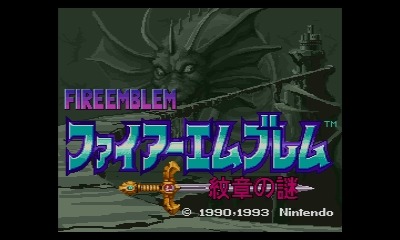
Original Release Date: January 21, 1994
Original Hardware: Nintendo Super Famicom
With Fire Emblem Gaiden maintaining solid sales even in the face of a waning Famicom market and some pushback over its design decisions, it was a certainty that the series would continue. While its cousin Famicom Wars had jumped over to the Game Boy, Fire Emblem would get a shot at the console big leagues. Now, it's important to remember that although most fans think of Intelligent Systems as a game developer first and foremost, they've also historically been instrumental in developing software tools and assisting Nintendo in various other hardware-related capacities. As such, they don't tend to release a lot of games around the launch of new Nintendo systems, since they're occupied with their other work. That has become less of a problem over time as Intelligent Systems has grown and Nintendo has relied on less proprietary hardware and software. During the first few generations of Nintendo hardware, however, Intelligent Systems games usually arrived late in the generation.
Fire Emblem: Mystery of the Emblem certainly released late in the Super Famicom's life, but it was less of a problem this time than it had been with the previous two games. While the SEGA Saturn and Sony PlayStation would launch in December of 1994 in Japan, they took a little while to catch on. Nintendo wouldn't have their Super Famicom replacement ready until late 1996, and in 1994 that successor was very much just sketches on a napkin as far as most Nintendo fans were concerned. No, the Super Famicom market was essentially in its prime in 1994, and with Fire Emblem now an established brand it was well-positioned to take advantage of that. Fortunately, Fire Emblem: Mystery of the Emblem turned out to be just the right product for its time and place, and it ended up being the best-selling game in the series until Fire Emblem Awakening arrived nearly 20 years later. Mystery of the Emblem ended up selling more than 770,000 copies in Japan, more than the first two games combined.

The plum release date surely assisted with that, but the game itself was well-suited for success. After Fire Emblem Gaiden's numerous changes from the first game received a mixed response, series creator and director Shouzou Kaga opted to roll things back in Mystery of the Emblem rather than try to fix what wasn't working. He did that in more ways than one. First, Mystery would return to the setting and characters of the first game, with Marth once again taking the spotlight. Second, most of the mechanical changes in Gaiden were discarded, with the support system being the only real survivor. Finally, perhaps in deference to Fire Emblem's late arrival on the Famicom, Mystery of the Emblem would include an abridged remake of the original game in addition to a full-length sequel. Newcomers could get to know the world and its characters without having to dig out their old hardware, while fans of the series could either enjoy revisiting the original game with a whole new presentation, or dive directly into the new content.
By including this remake of the original, the development team ended up running into memory issues yet again. This didn't interfere with the sequel content (referred to as Book 2), but some cuts had to be made to the remake (called Book 1) to make it fit. While the initial plan was to make it a complete remake, Book 1 ended up having to cut a handful of characters and stages. To be honest, it's not a huge loss. Having it all would be better, but you get most of what was good content-wise in the original game. Although the remake makes use of the new engine and all of its rules, the changes are quite slight. Mystery of the Emblem feels like it's playing things very safely after the criticisms of Gaiden. Its success through this conservative approach set down a template that the series had some trouble getting away from in the future, and it would nearly be the death of the franchise.
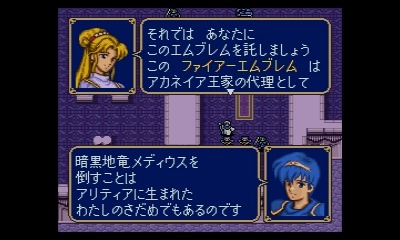
That said, there's a lot to appreciate in Mystery of the Emblem. The support system from Gaiden that was limited to Alm and Celica alone was greatly expanded here. While we're still pretty far away from the support conversations that have taken center stage in recent releases, multiple characters in Mystery of the Emblem have pre-existing relationships that convey combat bonuses when they're positioned near to each other in battle. This gives you a practical reason to pay attention to the story and lore, as knowing who gets along with who can give you a tactical advantage. This was an important step towards creating the shape of the series as we know it today.
Another highly welcome new feature is the game displaying movement range when a unit is selected. You no longer need to push along with the cursor to see where you can or can't go. The UI in general is a lot friendlier and easier to use in this game compared to the previous games. The game gives you access to your storage and character inventory in between stages, allowing you to easily pass items around and set up as you see fit. Fire Emblem would make major strides in this capacity in the next few games, but it's far enough along here that I think most people would feel somewhat comfortable going back to it. You still have to decide on your own whether or not it's a good idea to attack a unit and what the probabilities look like, though.
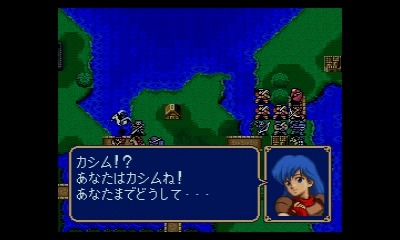
The other big change in Mystery is one that only ended up appearing in a few games before disappearing. Mounted units are now able to dismount, and indeed are forced to in stages that take place indoors. Depending on whether they're mounted or not, they'll only have access to particular weapons. While on their steeds, they have to use pole arms, while on foot, they're limited to swords. The idea isn't bad, and it makes a lot of sense from a certain point of view, but it ended up blurring the lines between job classes and making a mess of managing inventories. Later games would address the whole problem of horses in-doors by giving them a movement penalty instead. Kaga was clearly fond of dismounting, however, as he made sure to include it in Tear Ring Saga after he left the Fire Emblem franchise.
Naturally, with the move to 16-bit hardware, the presentation got a real kick in the pants. I don't think Mystery of the Emblem looks particularly good for a 1994 Super Famicom game, but it doesn't look bad, either. Series composer Yuka Tsujiyoko got a lot of mileage out of the improved sound capabilities of the hardware, too. With more memory to work with, the development team was able to add in a lot more information and story for all of the characters, giving the game a much more well-rounded feel. The story of Book 2 also does some interesting things, making one of your trusted playable allies from the first game into what appears to be the main antagonist. It ends up explaining his turn through supernatural means, but it's honestly plausible on its own without any of that silliness. While fiction tends to treat friends as a forever thing, real history shows that war-time allies often become enemies and vice-versa.
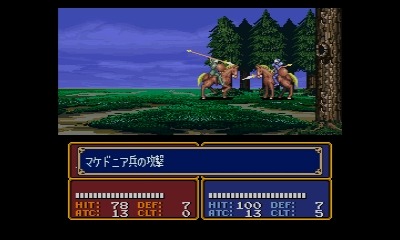
The maps and scenarios are well-designed as usual, and recruiting new characters once again largely occurs through conversations on the battlefield. While that can be stressful at times, I think it's an important part of what makes Fire Emblem distinct from other games in this genre. You can't simply put your strongest units forward and roll over the enemies, because one of them might need to talk to someone in the back ranks to join your side. You have to figure out how to get that potentially vulnerable unit into the middle of a group of enemies and extract them, which is a nice challenge. Recent games tend to compromise on this by having potential recruits be distinct from enemy forces, which I think accomplishes a similar goal. It's a little weird that certain units are so willing to fight Marth when they were once apparently his loyal friends, but I suppose the game's story can explain away whatever the characters don't. Marth is treated like a dangerous rebel, and I suppose some fools would believe that, considering the source.
With the massive success of Mystery of the Emblem, it was inevitable that Fire Emblem would get another release on the Super Famicom no matter how late it was in the system's life. What was more unexpected was that the 16-bit platform would play host to two more installments, with the last of the bunch releasing in late 1999. That's nearly a year after the Japanese release of the SEGA Dreamcast. That partly explains why the momentum and goodwill generated by Mystery of the Emblem was so short-lived. But I also feel like Kaga had his own ideas about where he wanted to take the franchise, and that might not have been compatible with Nintendo's view of things. As we'll see over the course of the next couple of articles, Kaga wasn't very interested in keeping Fire Emblem in a holding pattern, and I can't help but wonder if Mystery's unusually safe approach and the overwhelmingly positive response it received bristled him.
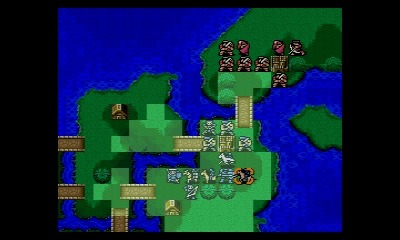
Whatever the case, Fire Emblem: Mystery of the Emblem holds up quite well to this day, and I would strongly recommend playing it were it not for one little thing. Namely, the two Books that make up this game have both received individual remakes that significantly fleshed them out. Fire Emblem: Shadow Dragon for the Nintendo DS managed to get an international release, and outside of its bland art, it's the best way to experience that particular story. Fire Emblem: New Mystery of the Emblem was also remade for the Nintendo DS, but it never got released outside of Japan. It makes some fairly significant changes to the story, but in terms of gameplay, it's by far the best way to enjoy Mystery. Of course, since Nintendo is yet to provide English players with any official means of playing this installment, it's somewhat inaccessible in either form. I imagine Nintendo will do something about that someday, but likely not soon.
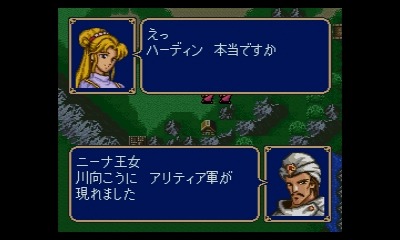
Previous: Fire Emblem Gaiden
Next: Fire Emblem: Genealogy of the Holy War
If you enjoyed reading this article and can’t wait to get more, consider subscribing to the Post Game Content Patreon. Just $1/month gets you early access to articles like this one, along with my undying thanks.
#fire emblem chronicles#fire emblem#fire emblem mystery of the emblem#gaming#retro#super famicom#intelligent systems#rpg
1 note
·
View note
Text
‘Persona 5’ reviews are in and — surprise! — everyone’s a fan
Image: Atlus
Persona 5 is great.
Yes, that’s not exactly news. The game launched in Japan last September, so we already knew that Atlus nailed the series’ first full sequel in almost 10 years. But it’s finally out in the U.S. on April 4, and the English-language reviews are in.
SEE ALSO: ‘Mass Effect: Andromeda’ is a forgettable, tedious trudge
It’s very long. It moves slowly at times. If you’re not a fan of Japanese RPGs, it’s a flat-out tough sell. But the art is jaw droppingly gorgeous, the sprawling story is easy to get hooked on and the dungeon-crawling is driven by a nifty, uniquely Persona take on combat.
In short: Atlus did it. Here’s what the critics have to say.
Eurogamer (Kassandra Khaw)
Real talk: if you’ve played Persona, if you’ve enjoyed JRPGs, if you even have a passing interest in Japanese media, there’s absolutely no reason to read this frankly ponderous review. Persona 5 is everything you’ve wanted: style and substance distilled into an experience worth waging cultural wars for.
If you don’t like JRPGs, well, I can’t help you there.
Everyone else? Buckle in.
GameSpot (Lucy James)
Persona 5 is a game overflowing with style. From bold black and red menus that leap off the screen to the pop-and-lock of scene transitions that carry the player from one colorful corner of Tokyo to the next, it’s a game about youthful exuberance and the power that lies within it. But its beauty isn’t just skin deep. Persona 5‘s gameplay systems evolve and coalesce over its 80+ hours to deliver a confidently executed role-playing experience that is not only satisfying, but worth the almost decade-long wait since Persona 4.
Image: Atlus
Like its predecessors, it’s part social simulator, part dungeon crawler. By day, you’re a high school studentbusy taking classes, visiting cafes, watching movies, and hanging out with friends. But by night you are the leader of the Phantom Thieves, a ragtag troupe of idealistic teenagers that infiltrate a parallel reality called the Metaverse.
Kotaku (Kirk Hamilton)
Much of Persona 5 comes down to efficient schedule management. (Its more exciting than it sounds.) You attend classes by day, then after school you make a choice: do you go to your job at the flower shop, or do you head into an alternate dimension and do battle? Or maybe you just want to hang out with that cute fortune-teller girl you met in the seedy part of town? Which activity will yield the greatest dividends, and which will feel like a waste of time?
On a given day you are usually given two blocks of time to fill: the after-school block and the evening block. Whatever you decide, youre necessarily setting aside your other options for another day. Choose to go to the batting range after school and you wont have time to visit the sexy doctor youve befriended. Spend your evening reading or making thieving tools and youll miss out on the chance to be interviewed by a local crime reporter. And if you spend the day dungeon-crawling and demon-fighting, youll be too tired in the evening to do anything but sleep.
With each passing day, the games calendar moves forward, inexorably pushing you closer to the conclusion. You have a couple hundred days; do with them what you will.
Ars Technica (Steven Strom)
Persona 5 can get away with its slow pace thanks to a striking and effective frame narrative that ducks in and out of the plot from the very beginning. After the casino heist goes wrong in the plot’s first major beat, the protagonist, codenamed Joker, is carted off into police custody. Most of the rest of the game is told in flashback as a bruised, beaten Joker is interrogated about his actions and those of his teammates.
Image: Atlus
Said teammates are called “Confidants” in Persona 5, a slight rebranding of the “Social Links” from the last two Persona titles. These are the fore- and background characters whose relationships with the main character form the backbone of the Persona series these days.”
Arcade Sushi (Sarah LeBoeuf)
With each passing day, the games calendar moves forward, inexorably pushing you closer to the conclusion. You have a couple hundred days; do with them what you will.r. Before he can even get settled in, he has a run-in with an abusive coach, finds h series these days.ar-perfection in the previous Persona games to make fighting something of a game within itself. Discovering enemies weaknesses and how best to exploit them, leveraging your real-life friendships to get more out of your teammates in these alternate realities, managing health and SP (mana), and even deciding what to do with the shadows once youve knocked them down are all part of the battles.
Polygon (Philip Kollar)
Those dungeons are excellent, by the way, and by far the biggest single point of improvement between Persona 5 and its predecessors. Rather than the randomized dungeons of past games, each “Palace” in the Metaverse is a meticulously designed setpiece, a series of challenges ranging from stealth to puzzles to just plain combat. Exploring dungeons was often one of the most boring parts of past Persona games; now its a delight that constantly pushed me into new ways of playing.
Image: Atlus
If you miss the old randomized dungeons, they do still exist in a totally optional form. Since you cannot return to the main story dungeons once theyve been completed, grinding is relegated to Mementos, a labyrinth that gets deeper and full of more dangerous opponents the further into the game you progress. Mementos provides a nice space to search for loot and complete side missions including some that youll be sent on by your confidants to progress your relationship with them but you can also completely ignore it if youd rather not worry about it.
Digital Trends(Michael Rougeau)
Many of things that make Persona 5 compelling were present in Persona 3 or Persona 4 as well, but, mechanically, the game just feels better, and easier to handle. Many of the games biggest improvements technically amount to simple quality of life changes game developer speak for small improvements that make a big difference. When walking around Tokyo, for example, you can easily open the map to check which social links are at what locations, then easily fast travel directly to them. Friends and contacts who want to hang out will often text you directly, making your life a little less stressful as you deliberate what to do with your time.
Similarly, P5 retains its puzzle-style fighting system, which focuses on discovering enemies elemental weaknesses, but now once you do, you can tap a button to have the game select a good move for you, saving time. New abilities let you pass your turn to teammates to set up strategic timing, or even swap teammates out in the middle of battle. Plus, you now gain new personas magical spirits that grant your main character more powerful abilities through a fun interrogation mini-game.
The list goes on. New players will marvel at how easily Persona 5s interface and features keep the game accessible and easy to navigate, and series veterans will wonder how they ever lived without this stuff.
GamesRadar+ (Susan Arendt)
Persona 5 is just about perfect in every way it can be, with the sole exception of its pacing in the final acts. The last two dungeons are a slog, forcing you to solve a series of similar puzzles long after they’ve lost their ability to either challenge or intrigue. It’s an aggravating misstep at what should be the most thrilling part of the entire journey, but the revelation of the villain’s true identity reinvigorates the sluggish pace before it loses all momentum. It should also be mentioned that players already familiar with Persona‘s basic format will likely find themselves feeling constricted by the game’s opening hours, which gently ease newcomers into the many, many different systems at play. It’s a fair frustration, but the tradeoff is Persona 5 being an ideal entry point to anyone new to its peculiarities but intrigued by its promise.
Other than that, Persona 5 is simply phenomenal. The voice acting is outstanding, the music is genius, the art style is so slick it’ll raise your personal coolness level just from being in close proximity to it. Playing Persona 5 will make your hair glossier, increase your vocal range by an octave and add 7.32 years to your overall life expectancy. Play it enough times and you’ll likely not only be able to levitate but also make a perfect omelette while in midair. It’s that good.
WATCH: Check out Samsung’s latest ‘Gear VR’ and ‘Gear 360’
Read more: http://ift.tt/2obDxEW
from ‘Persona 5’ reviews are in and — surprise! — everyone’s a fan
0 notes